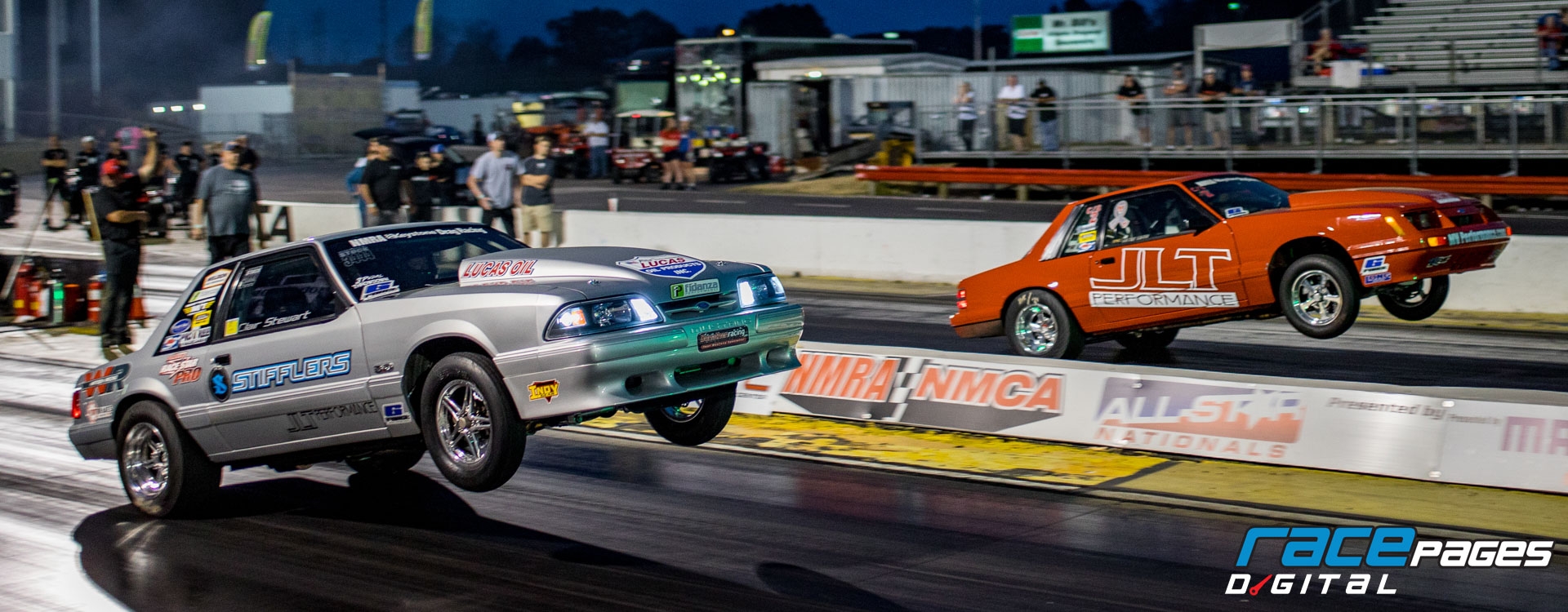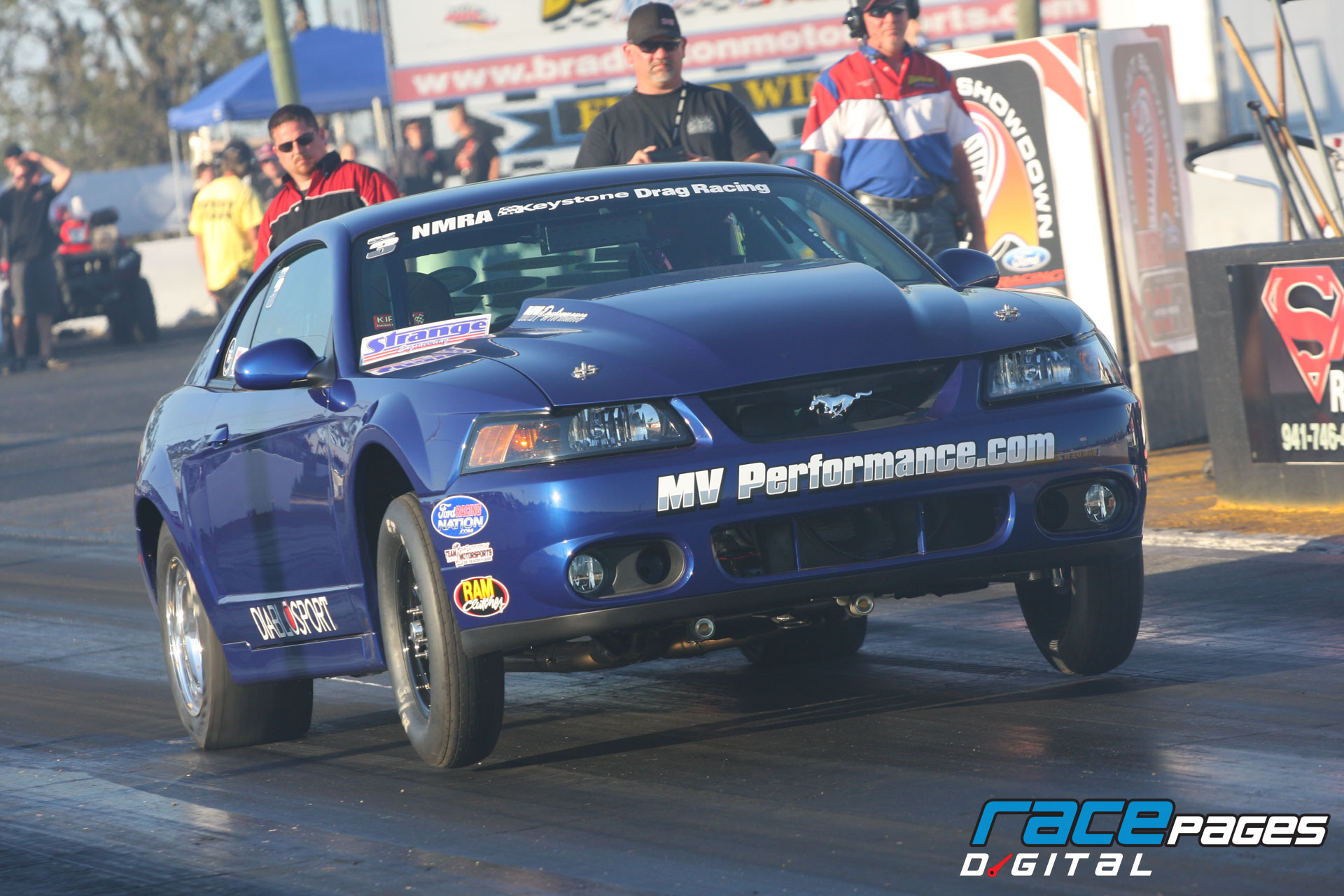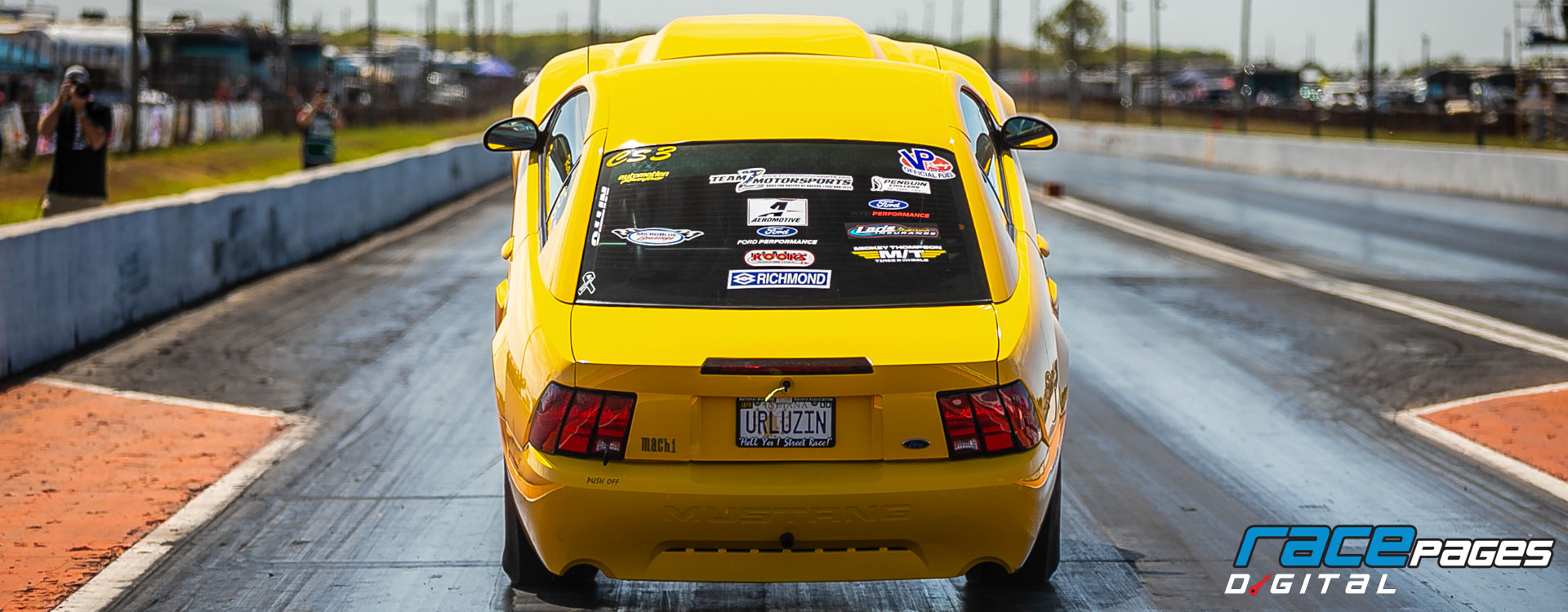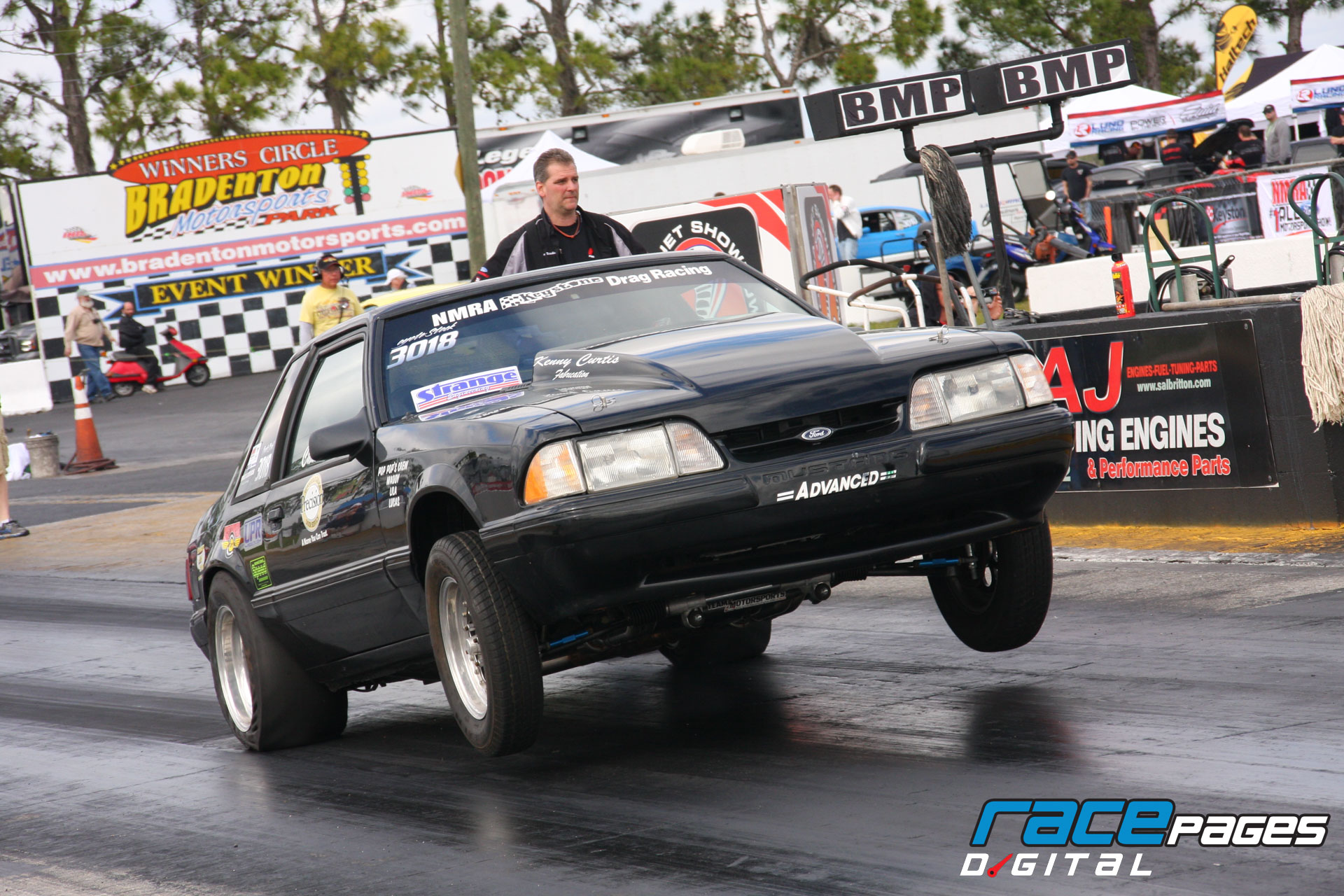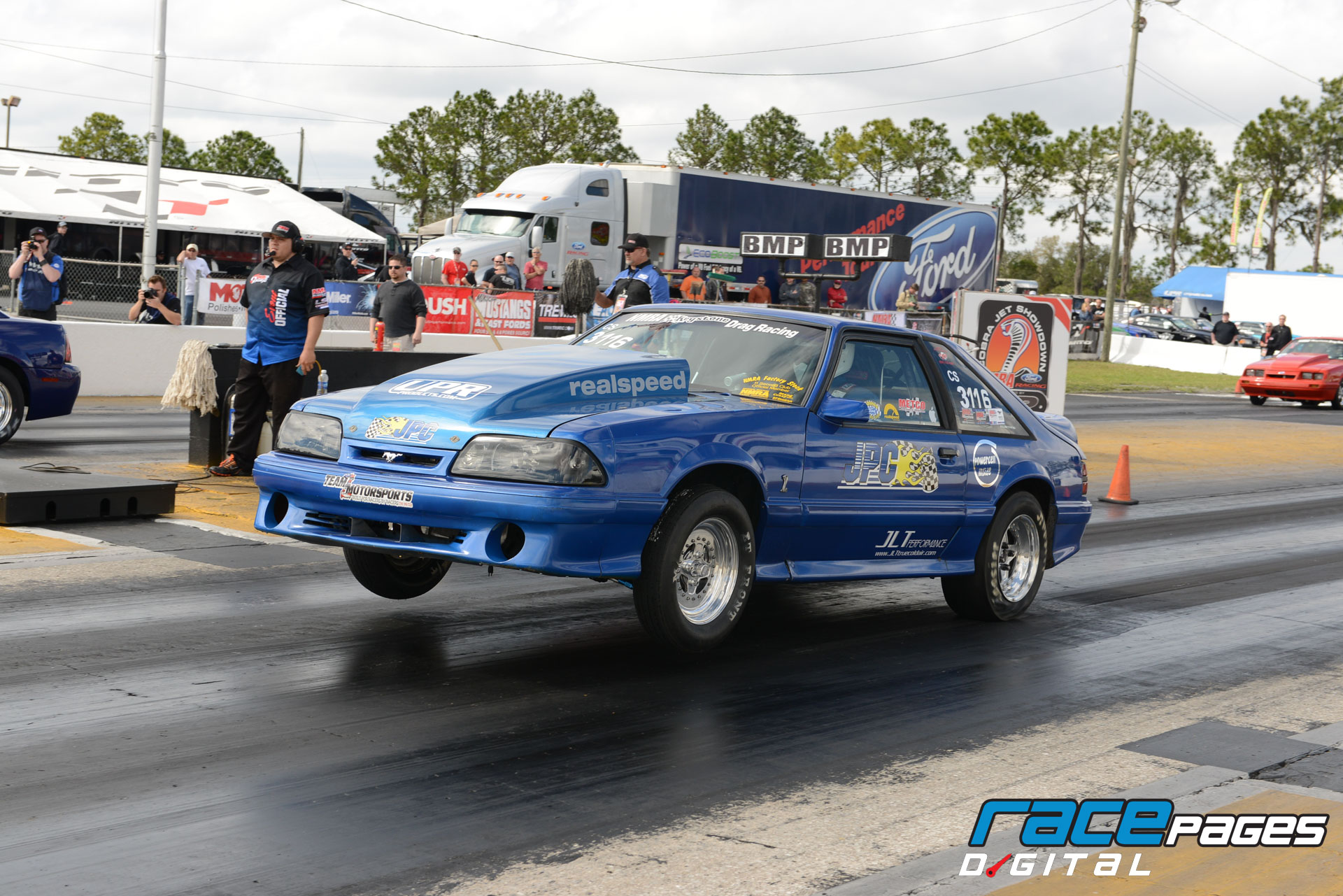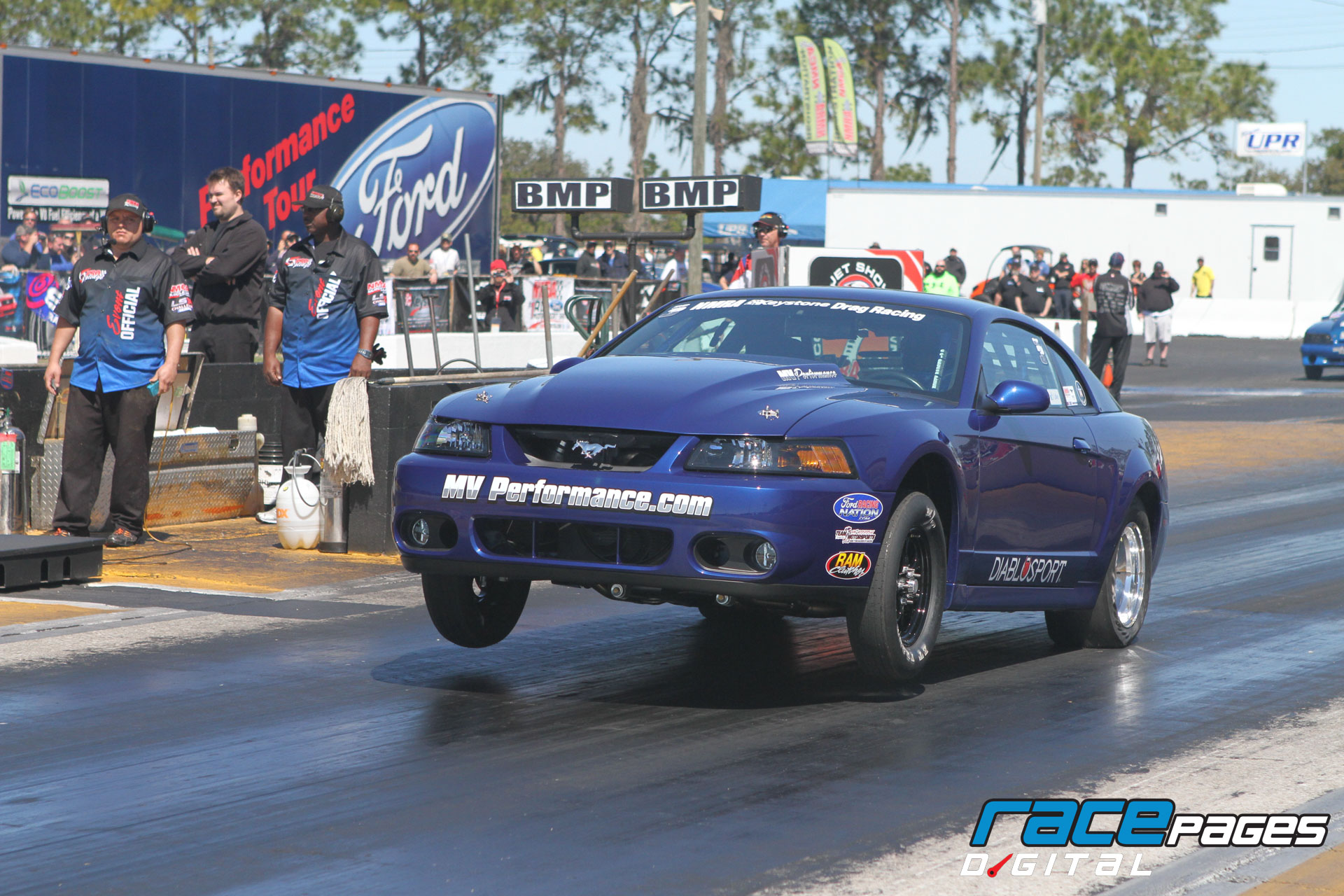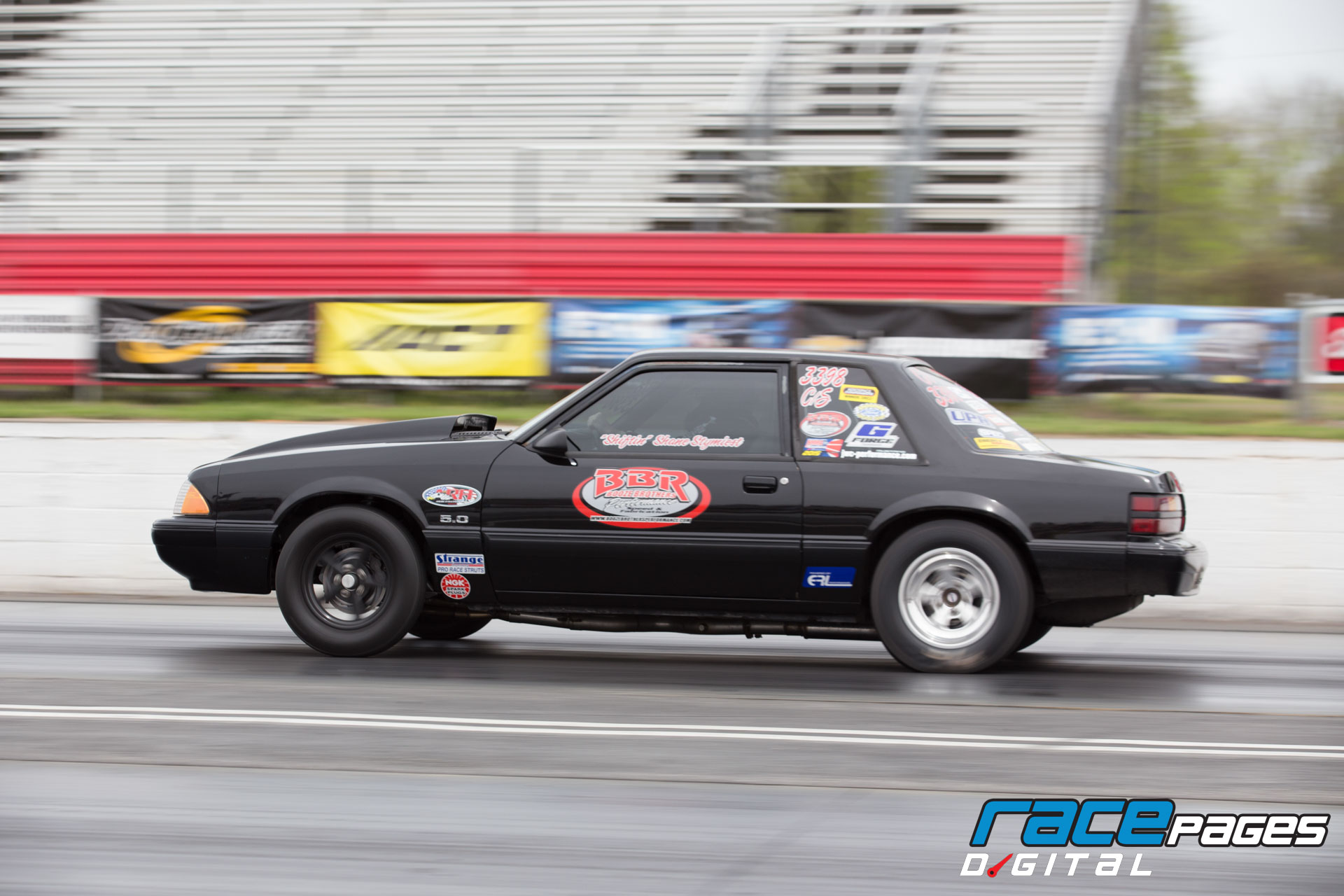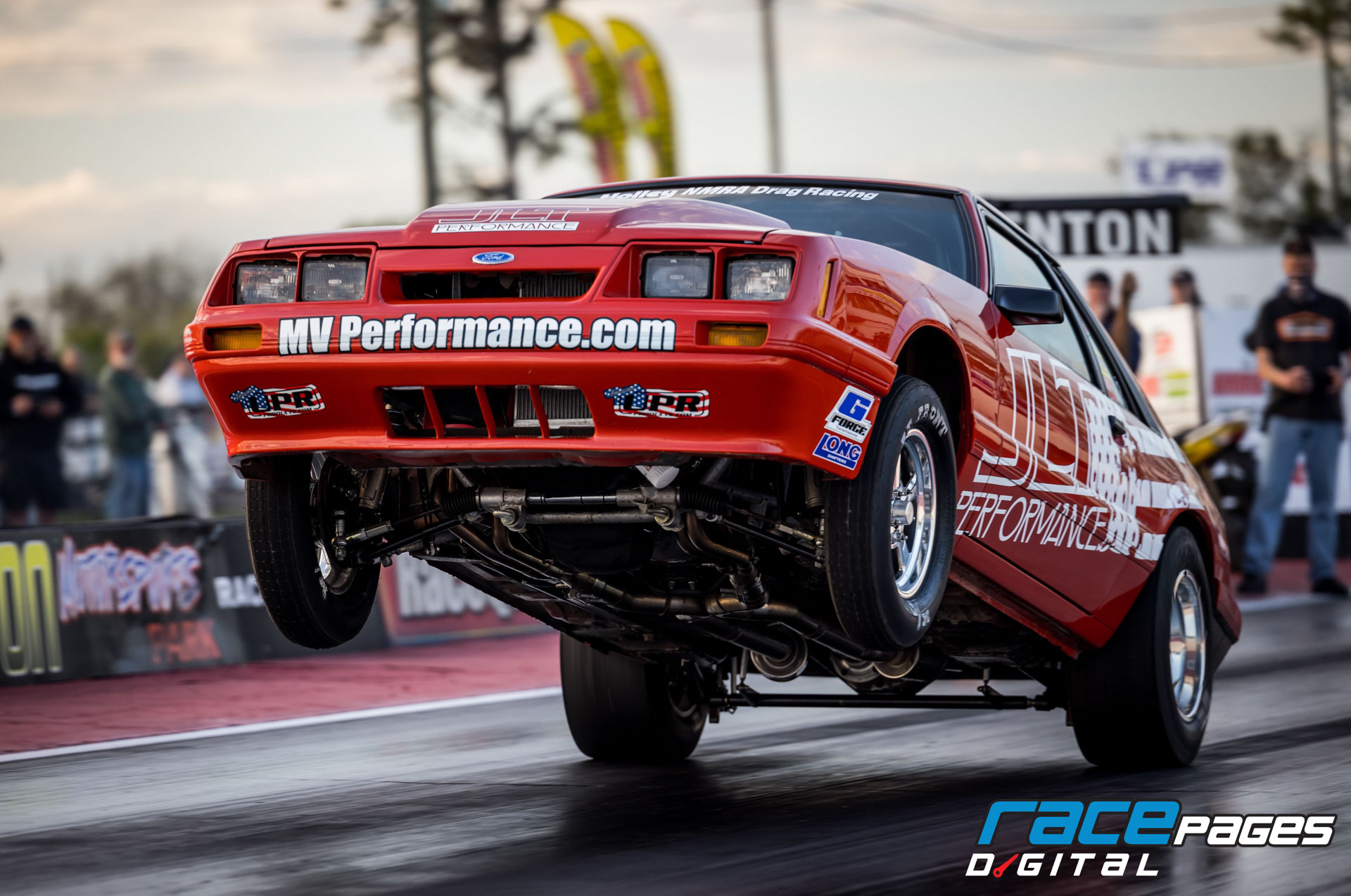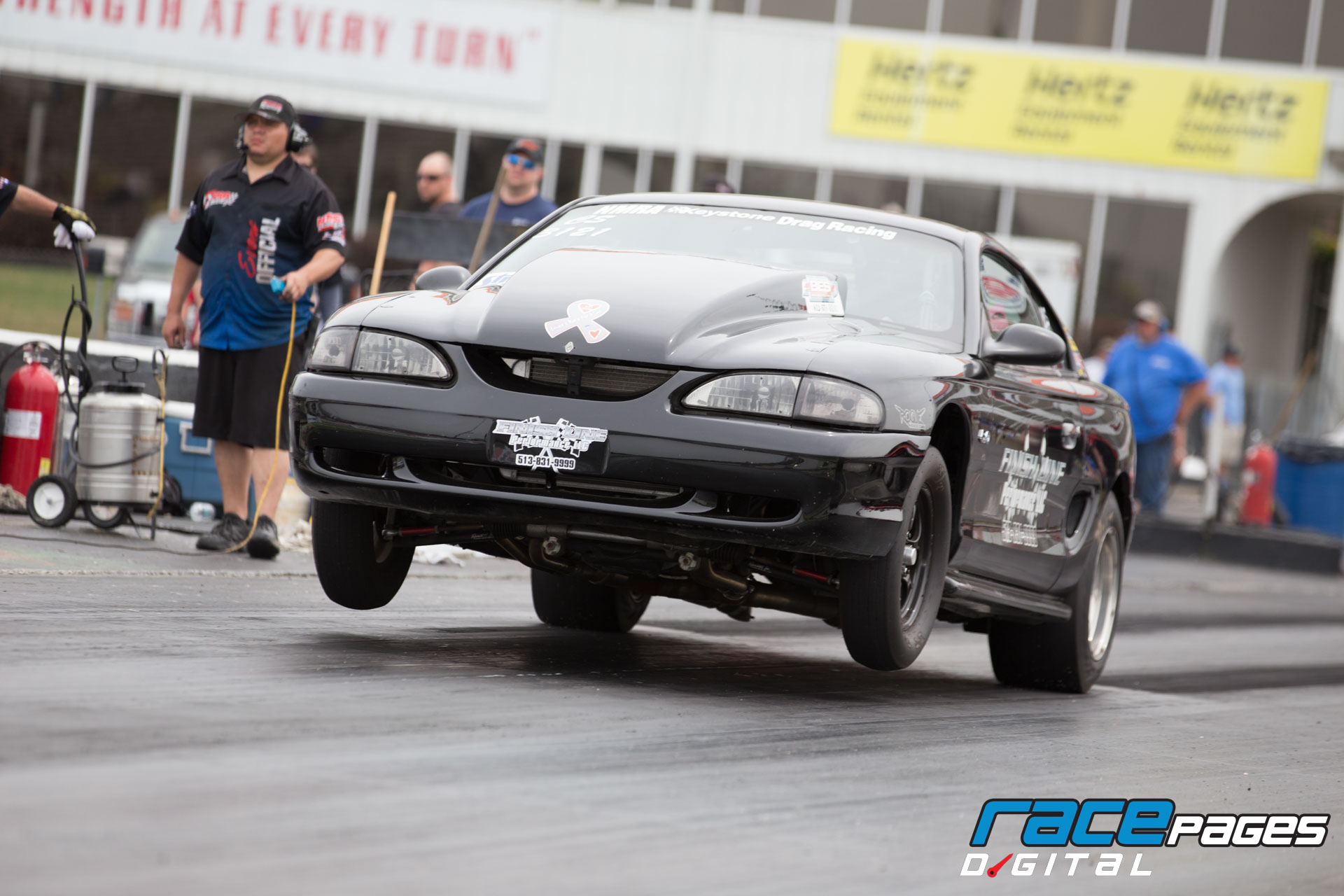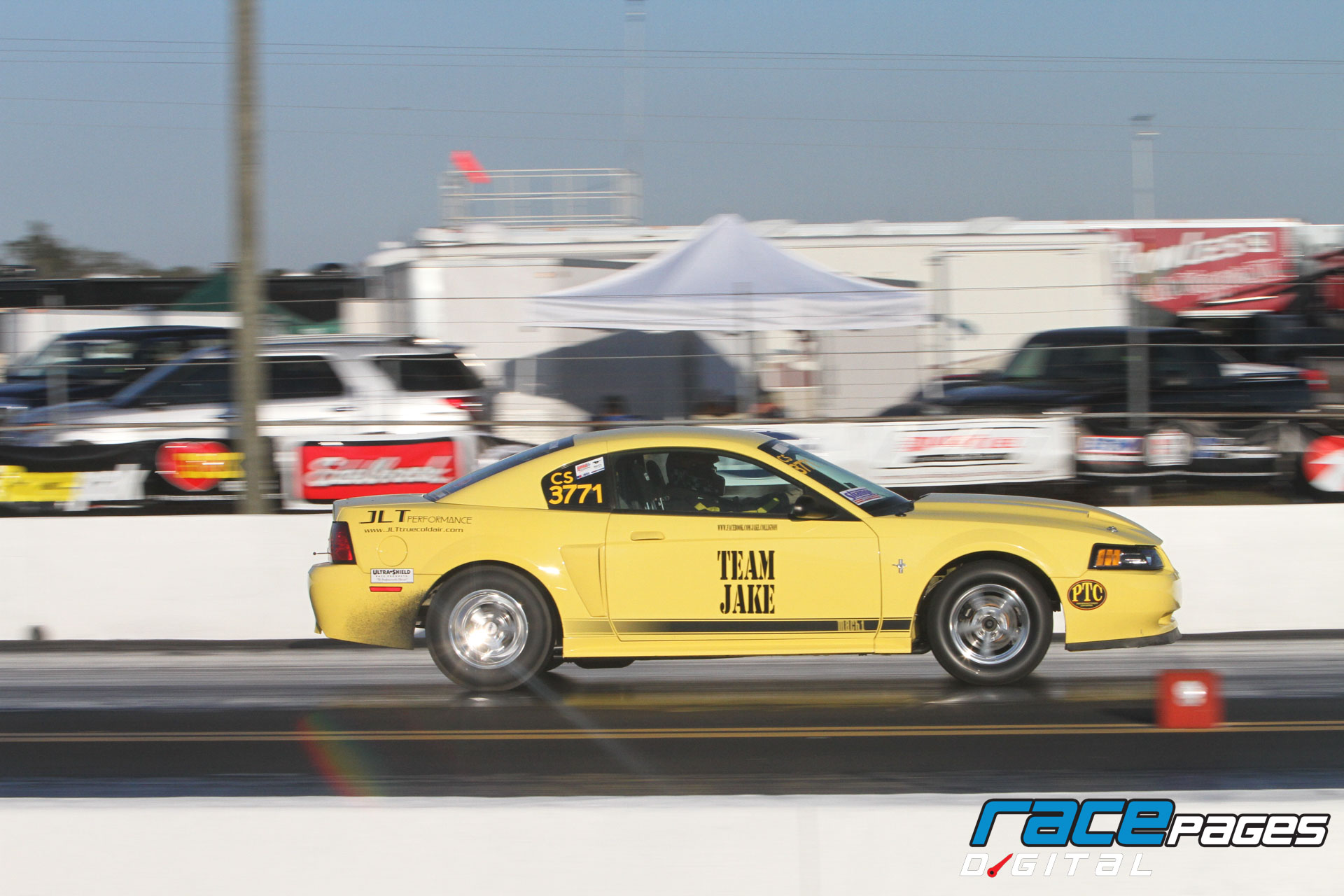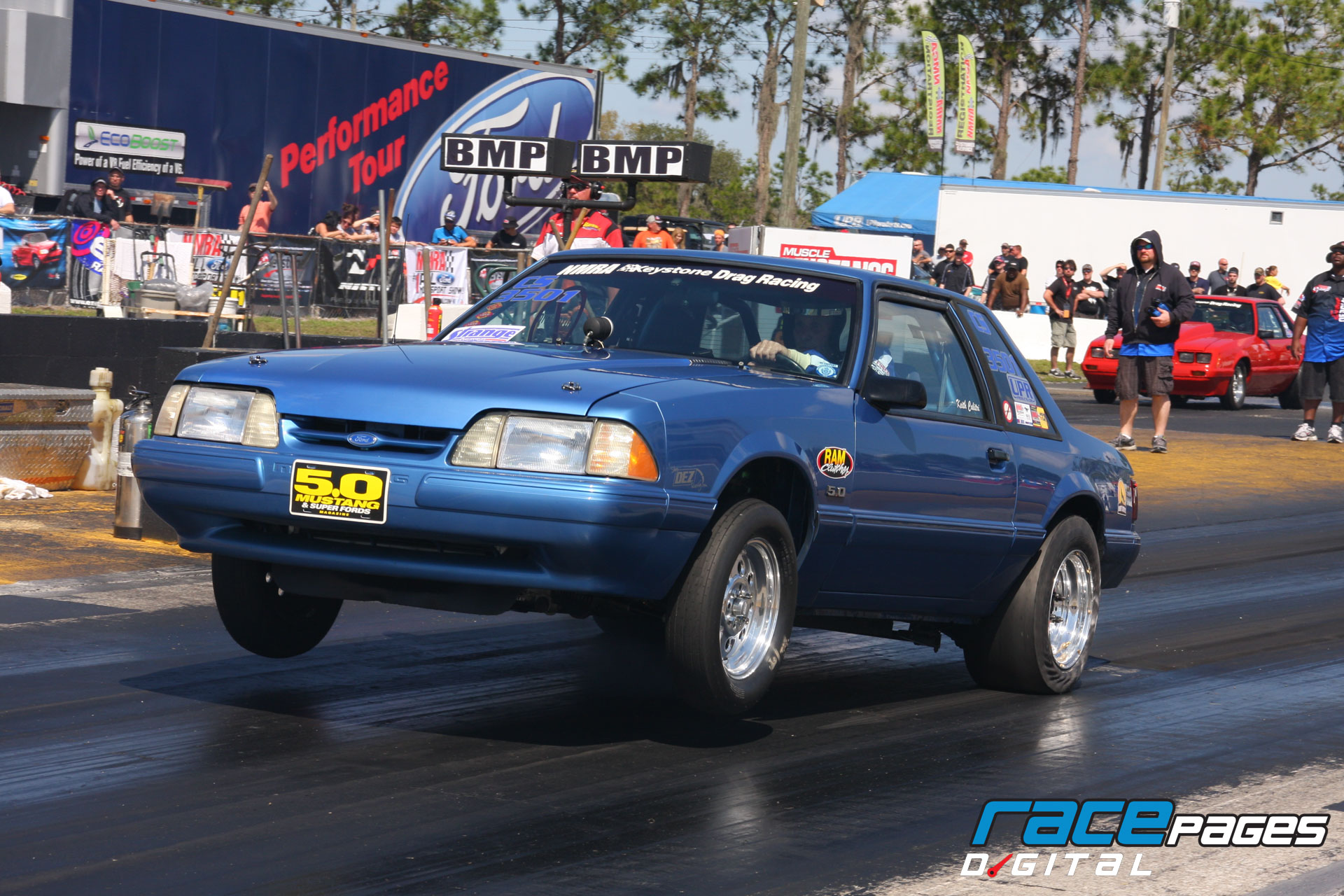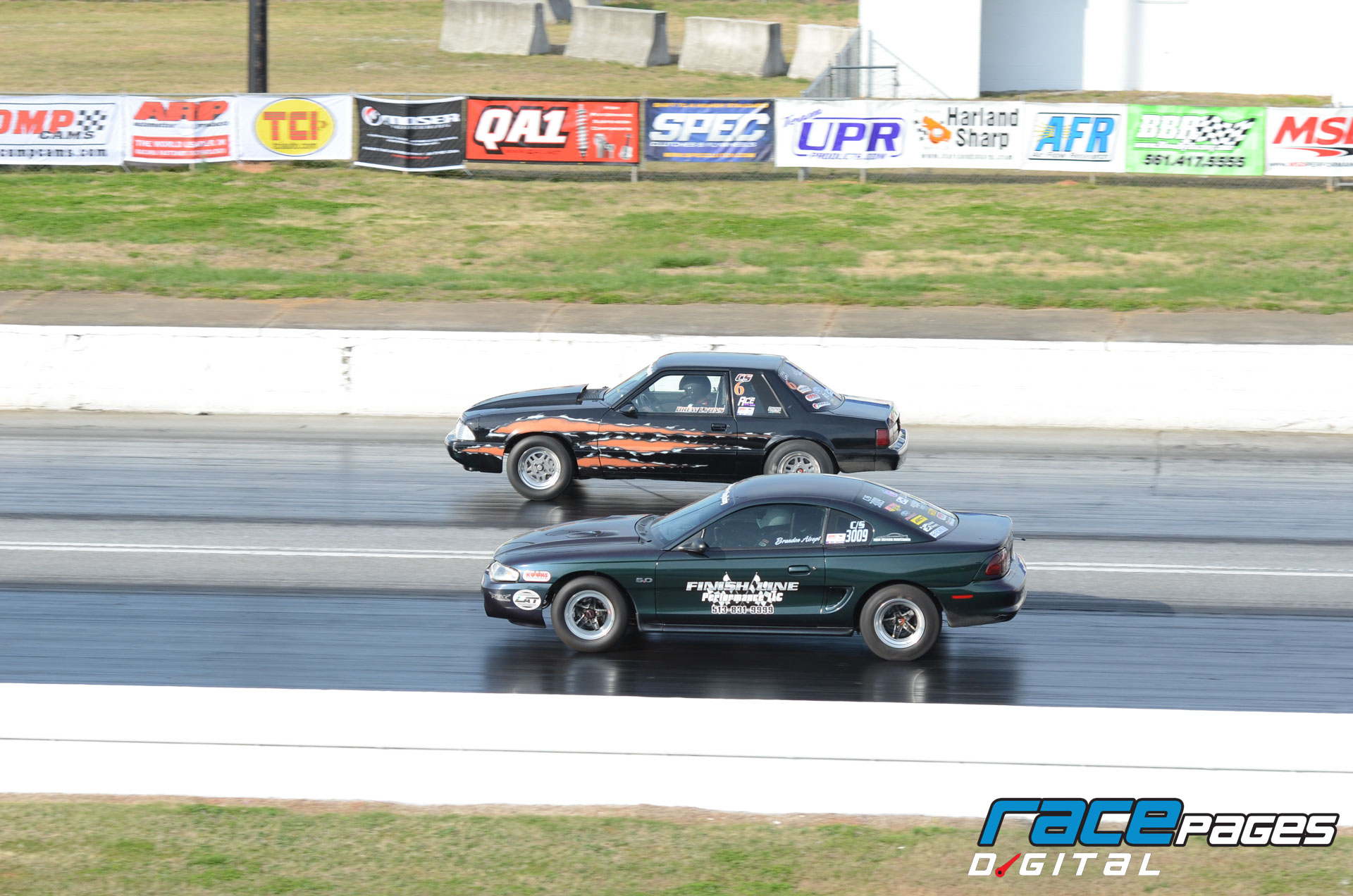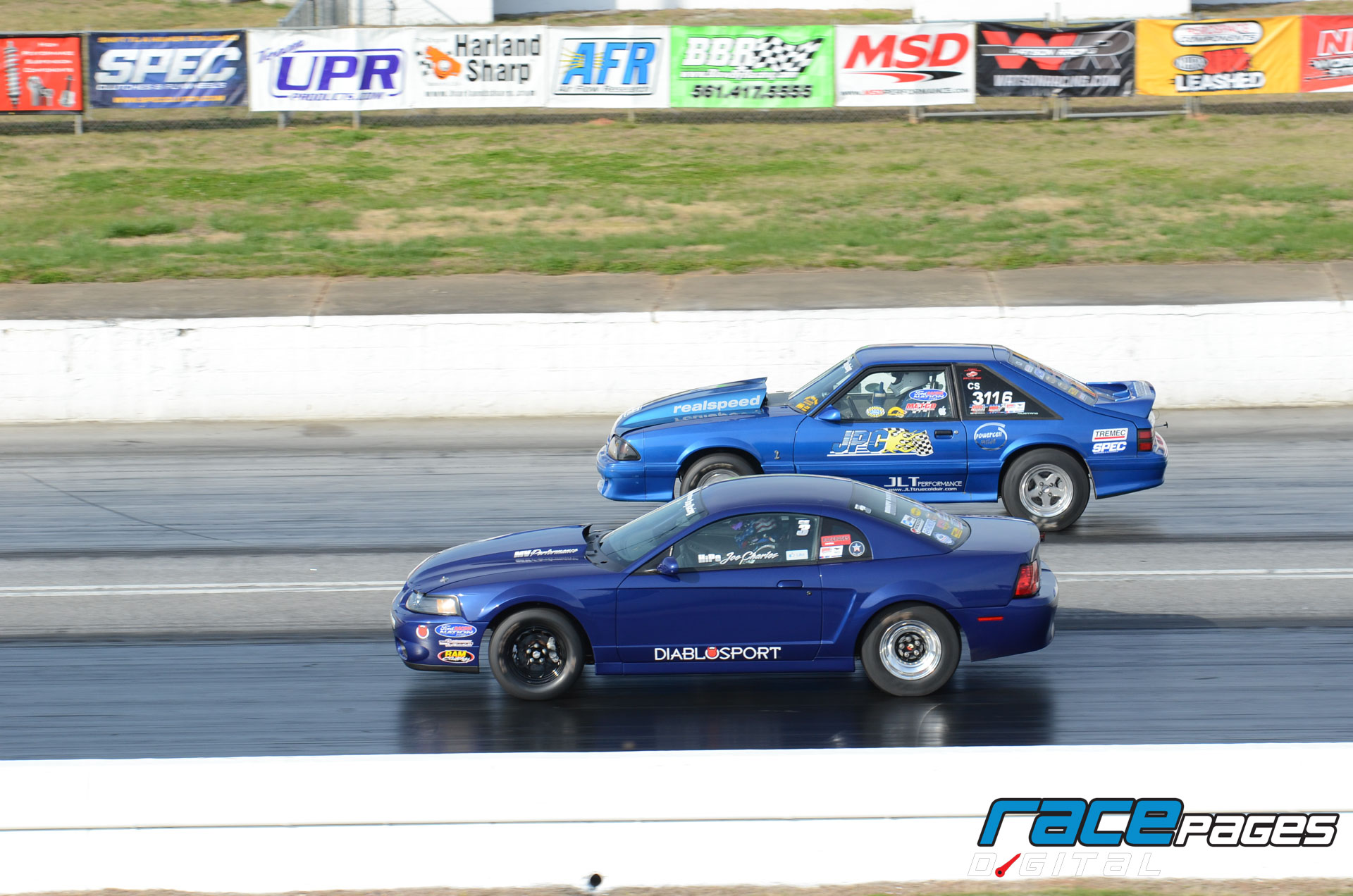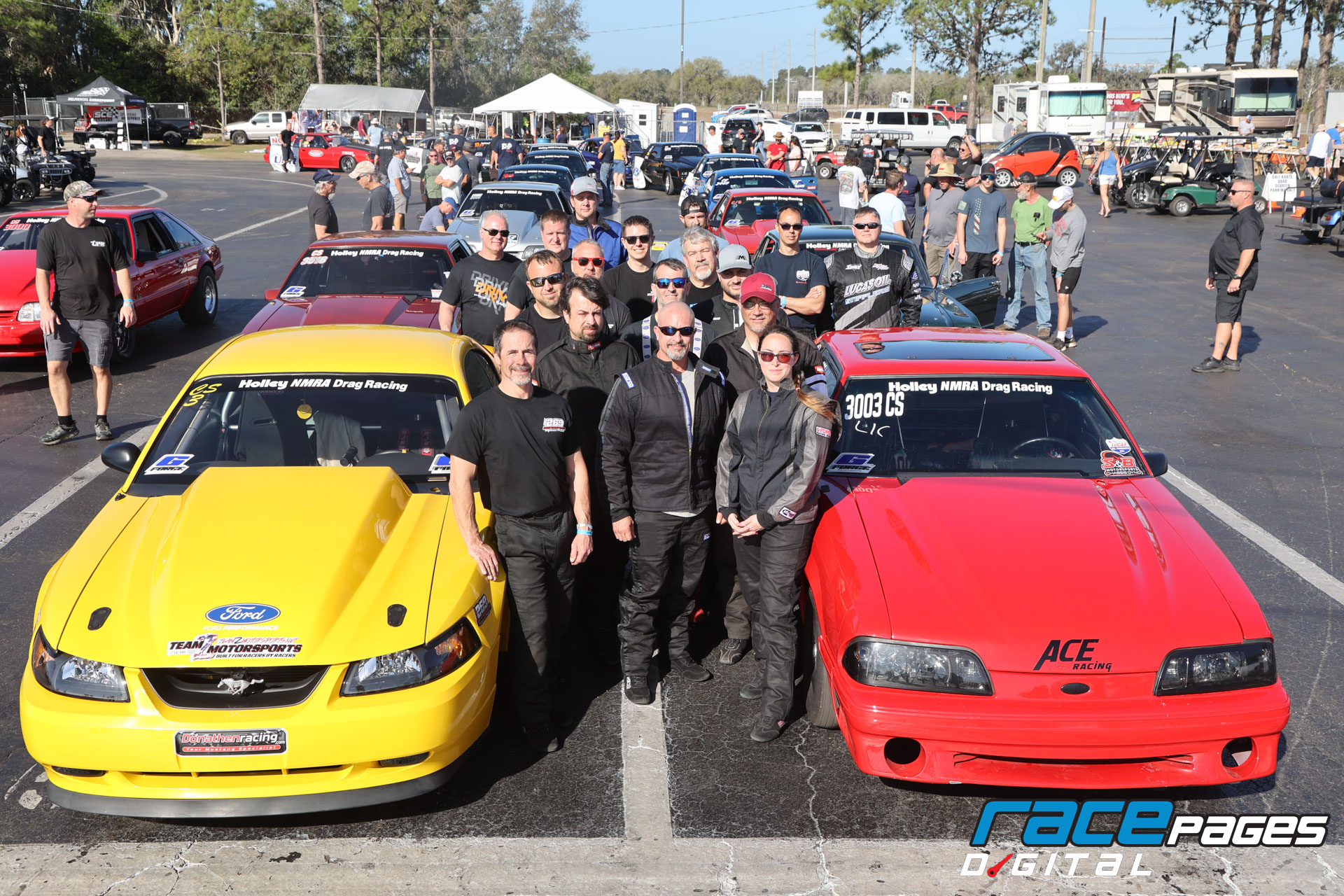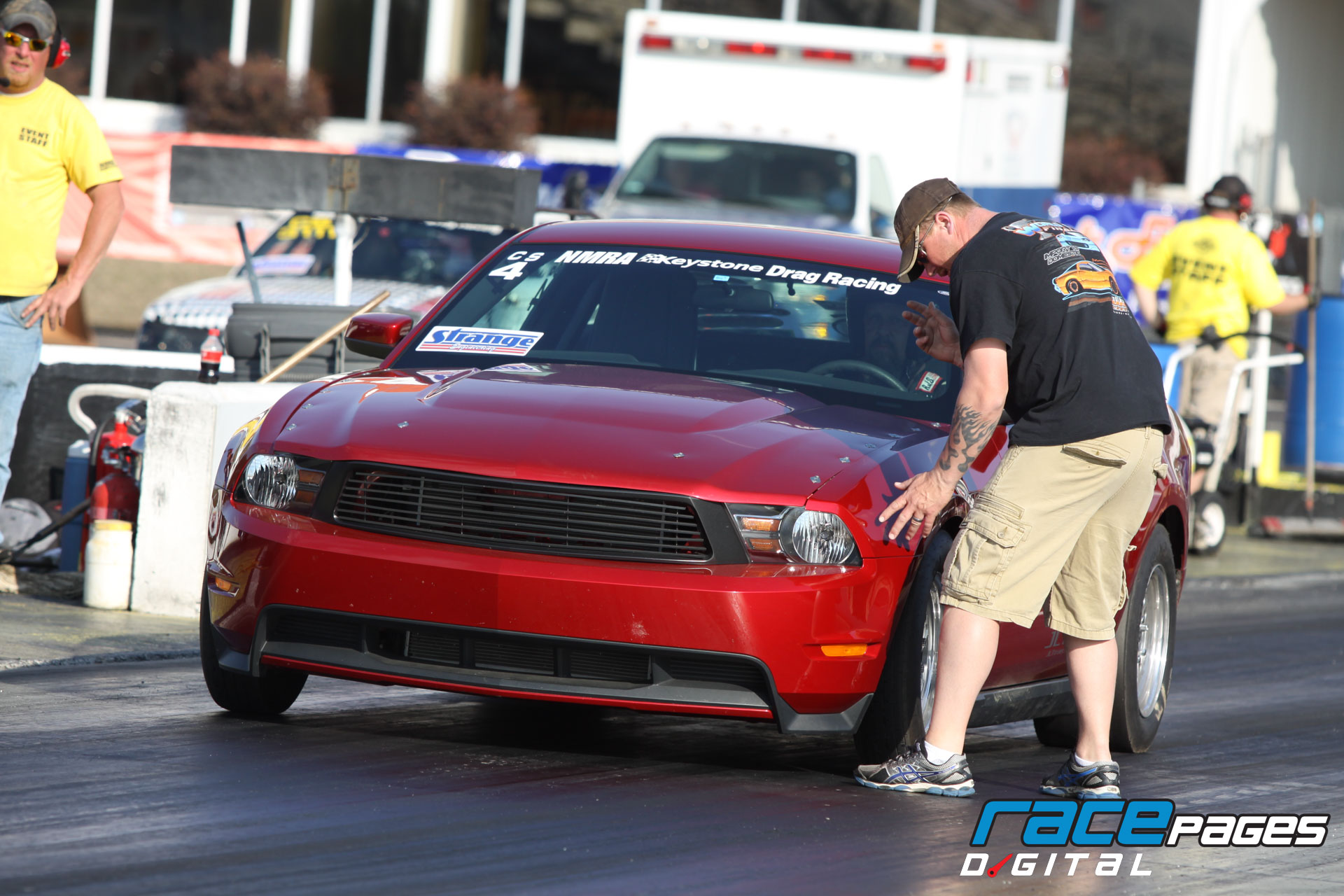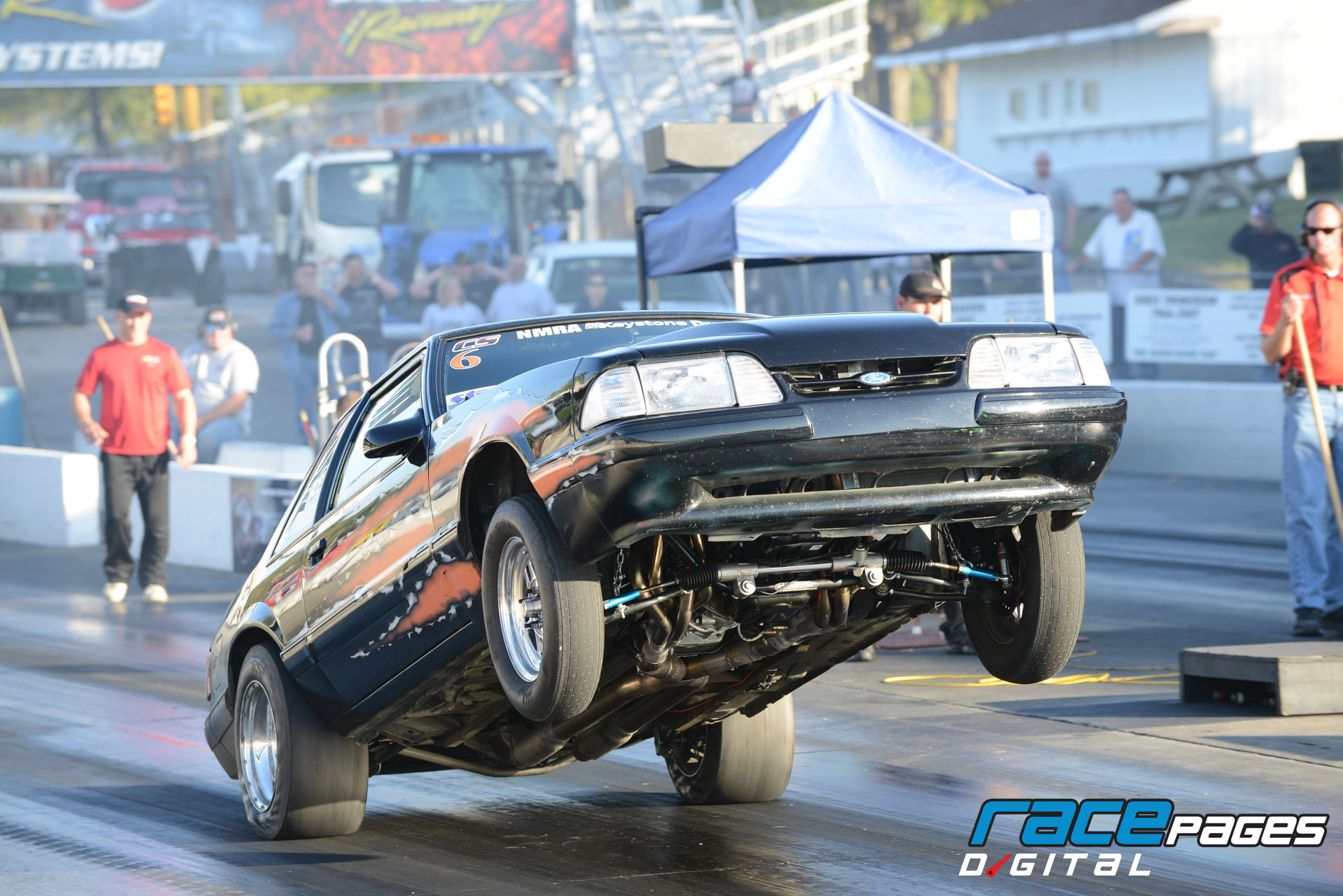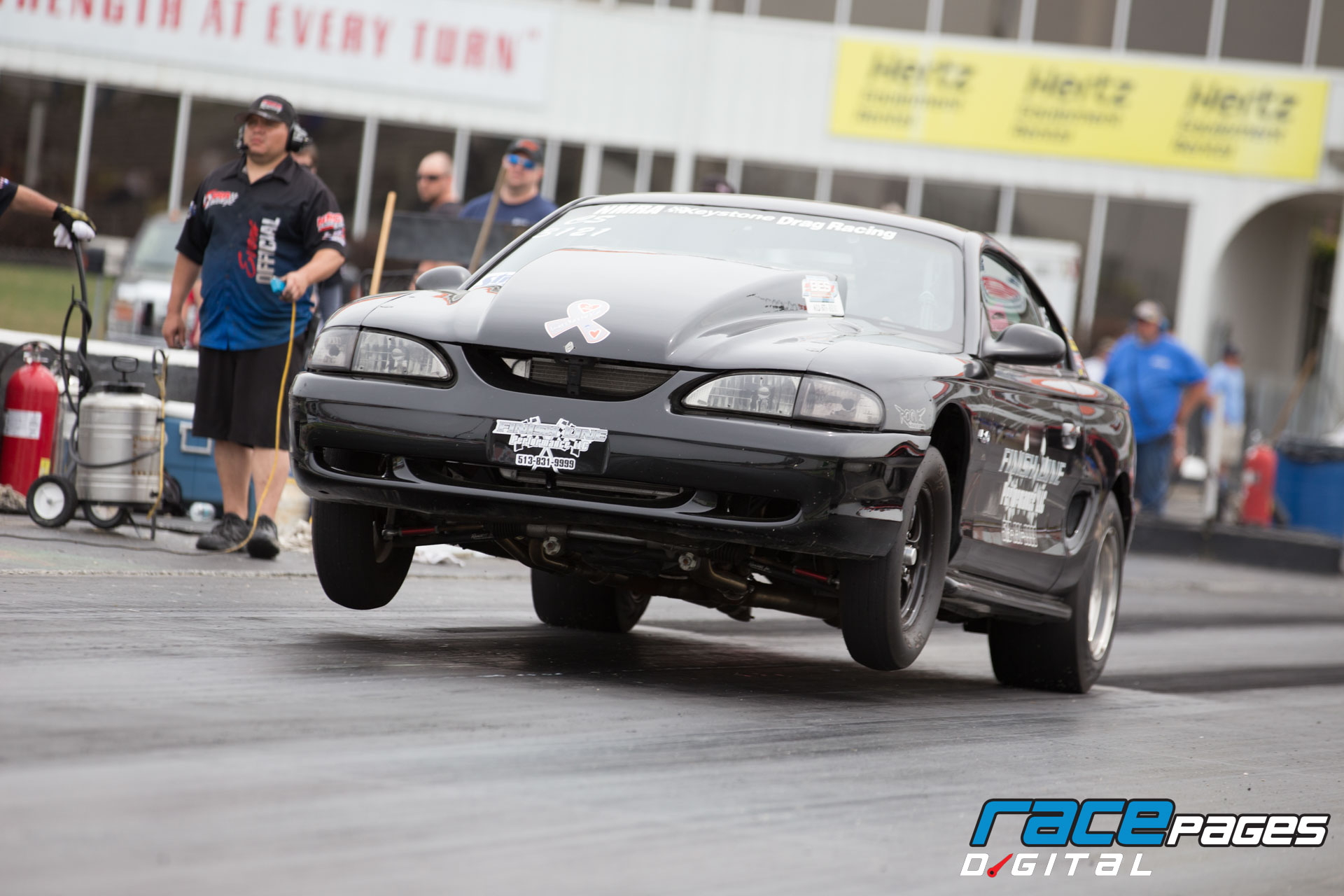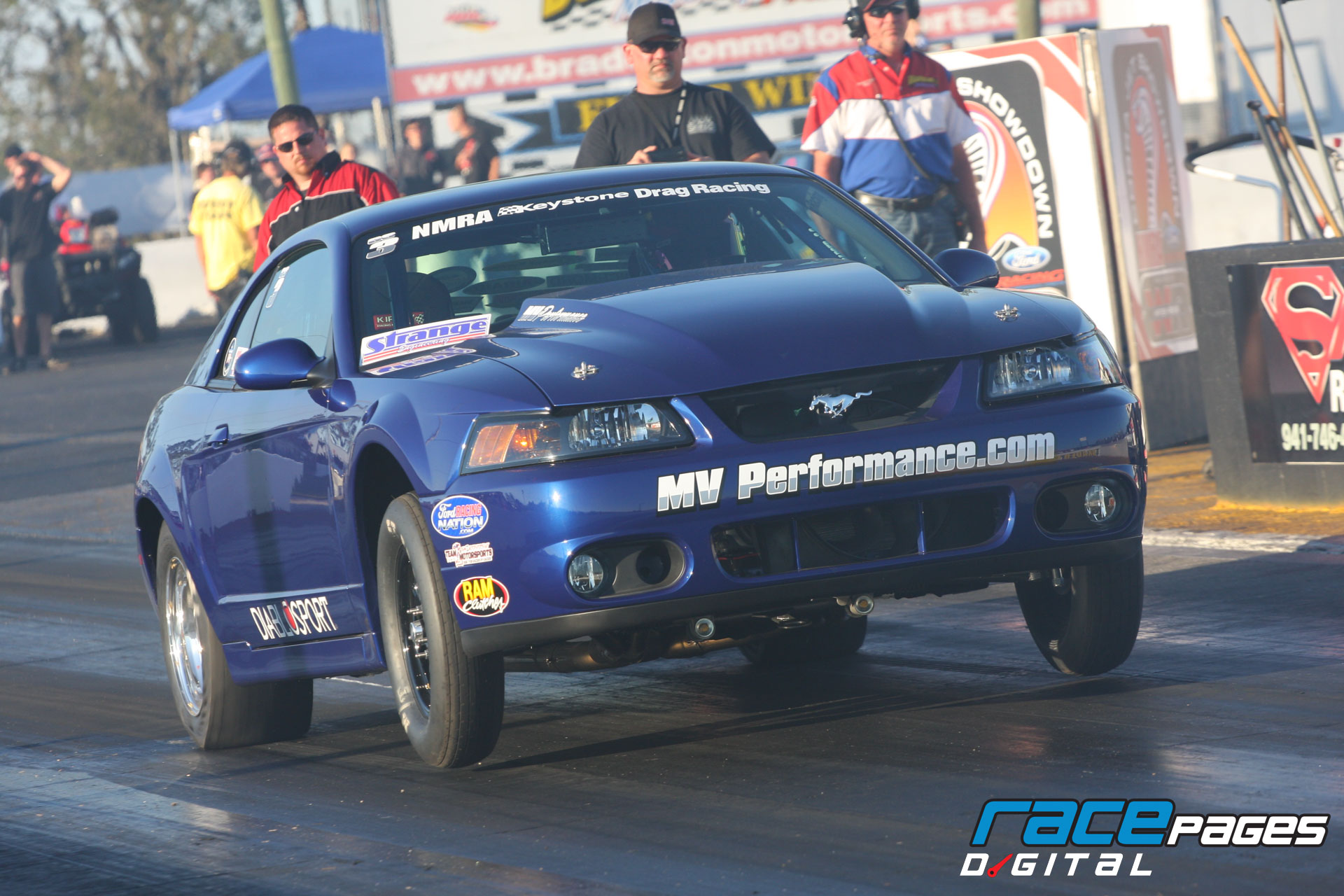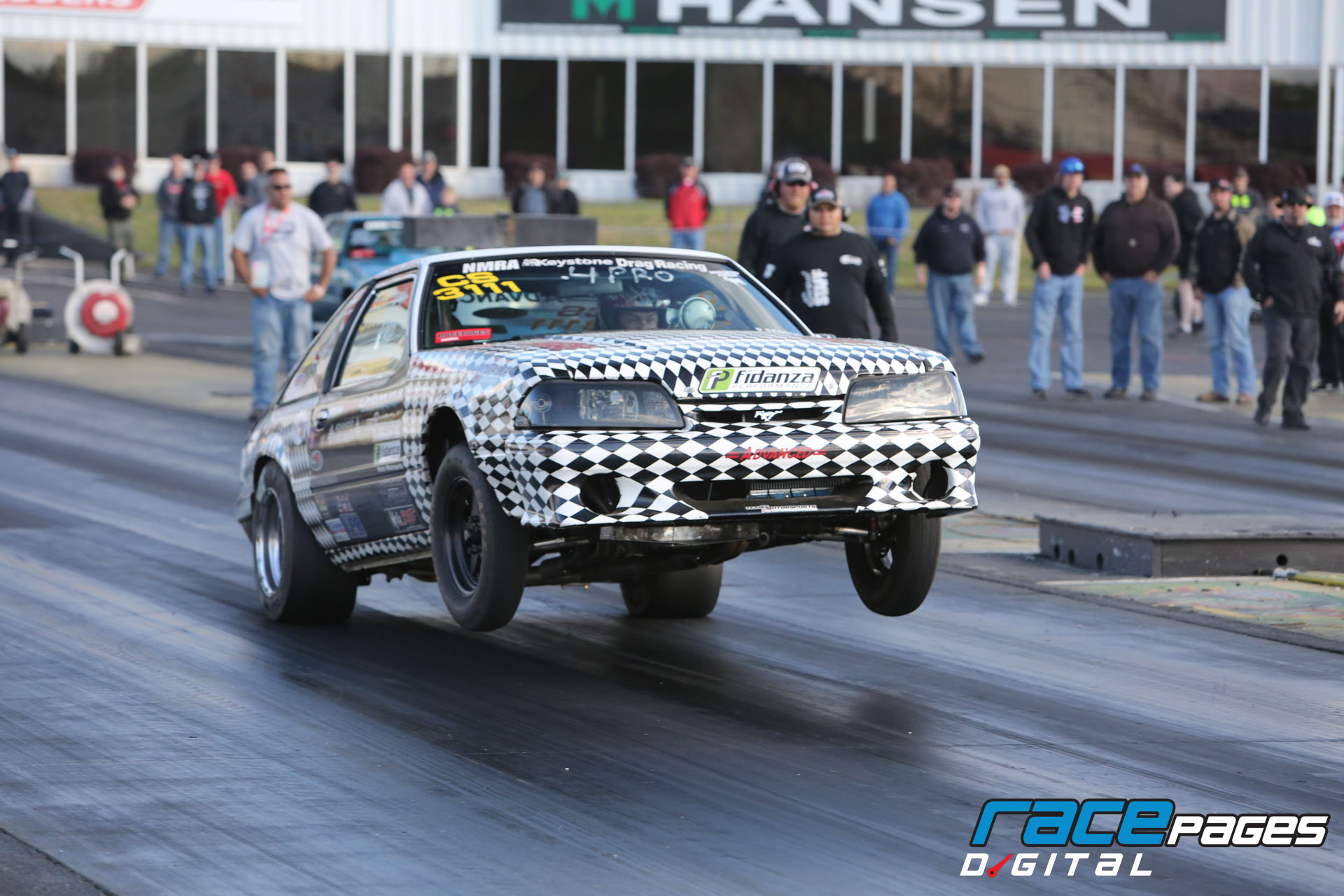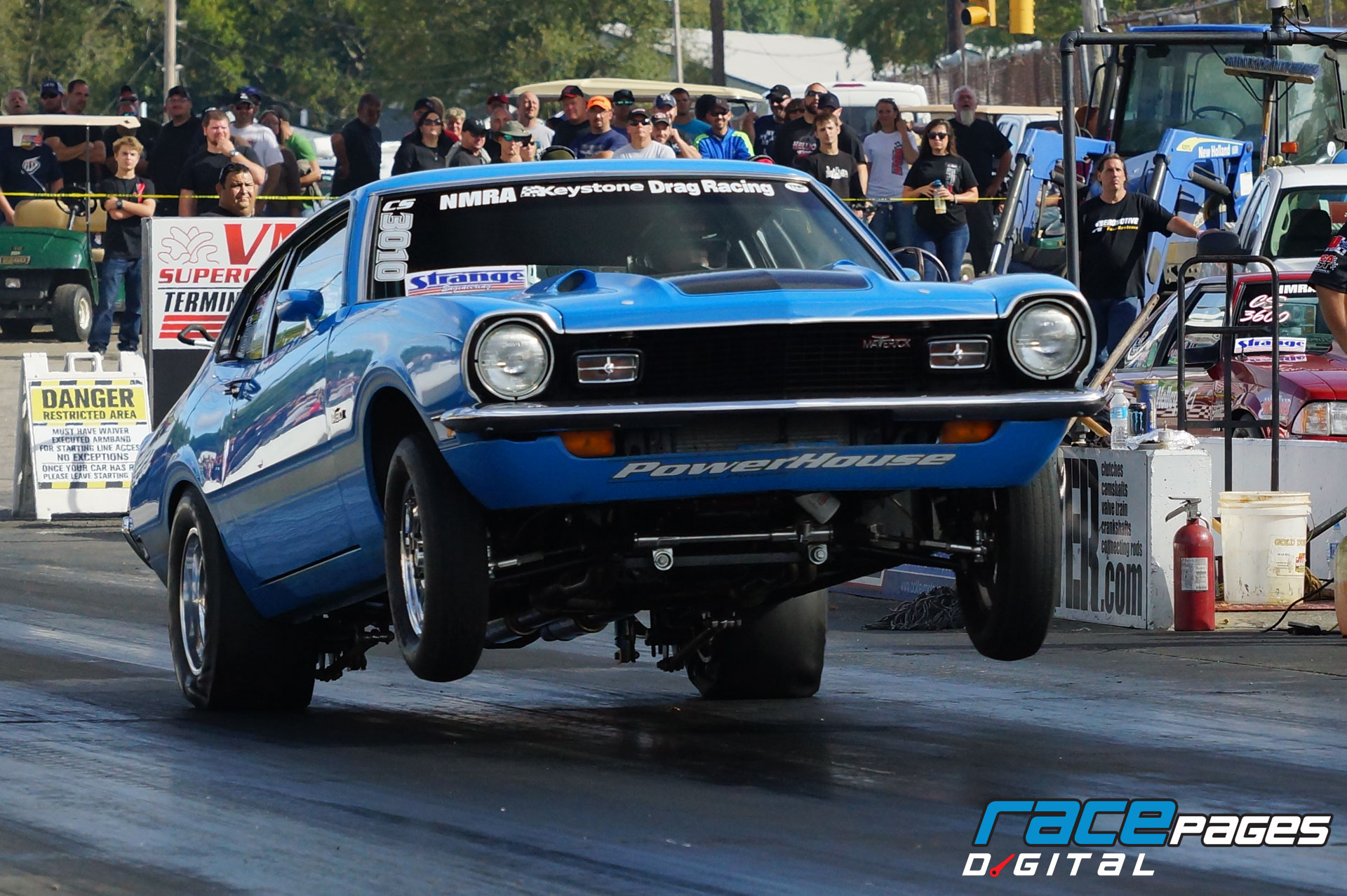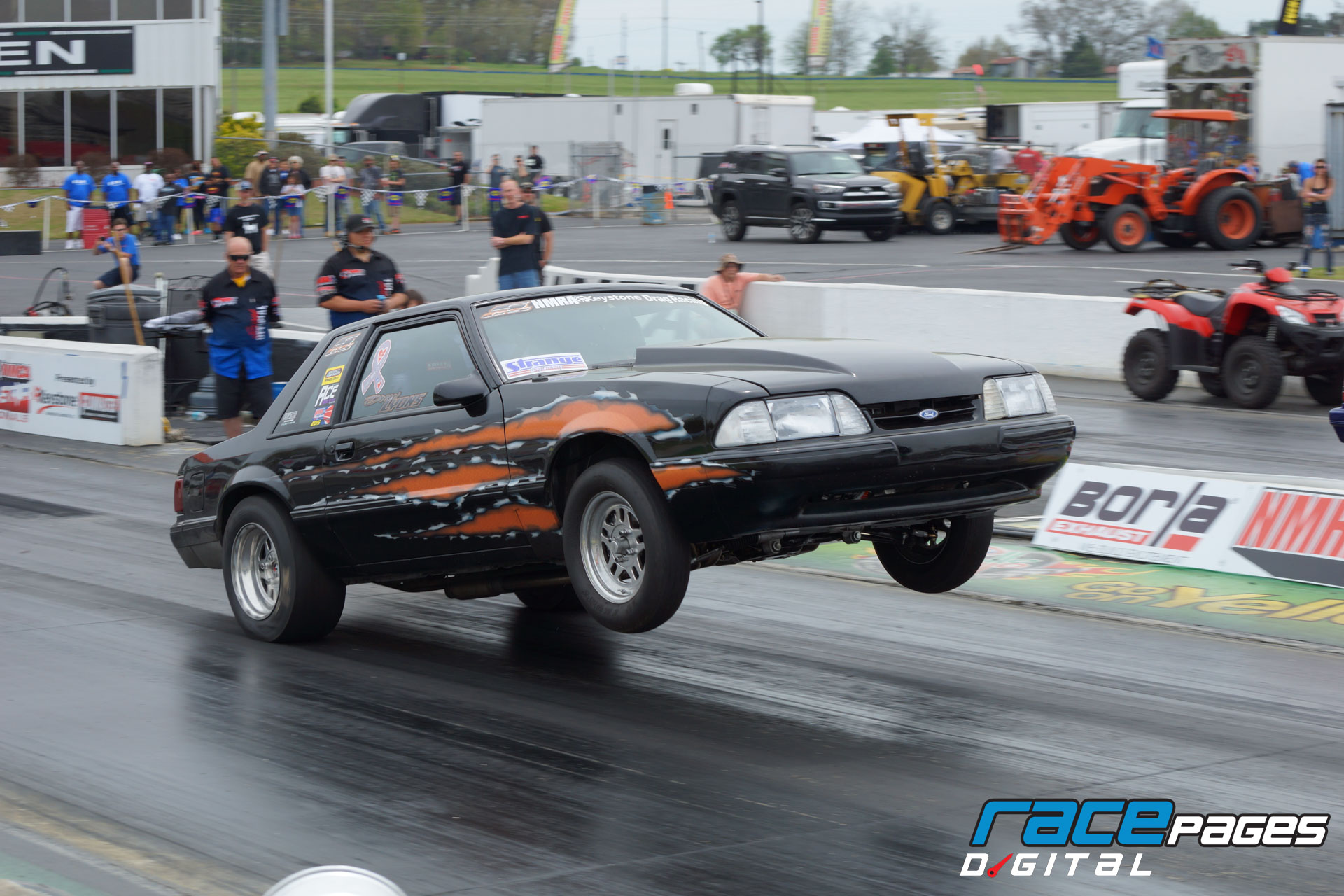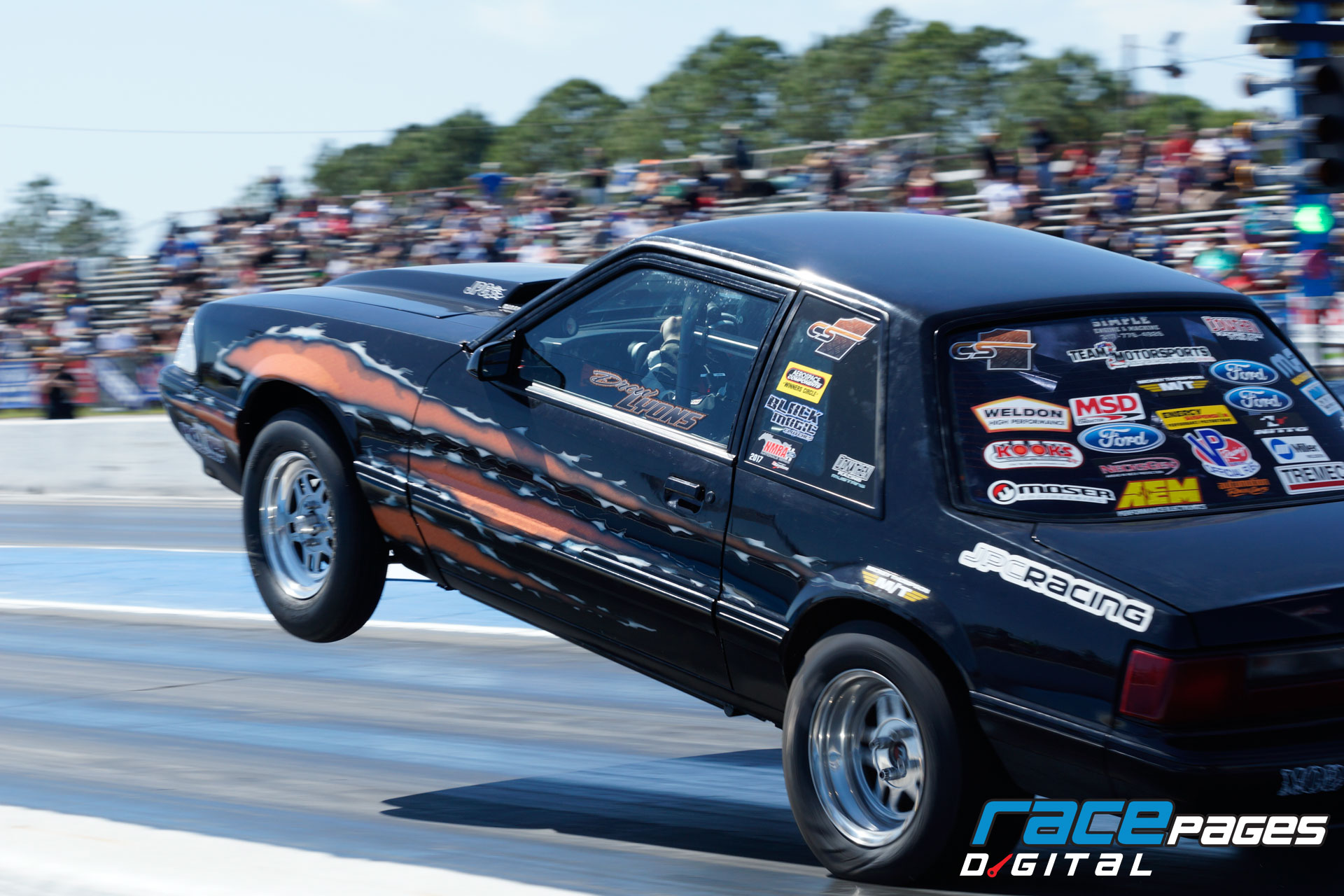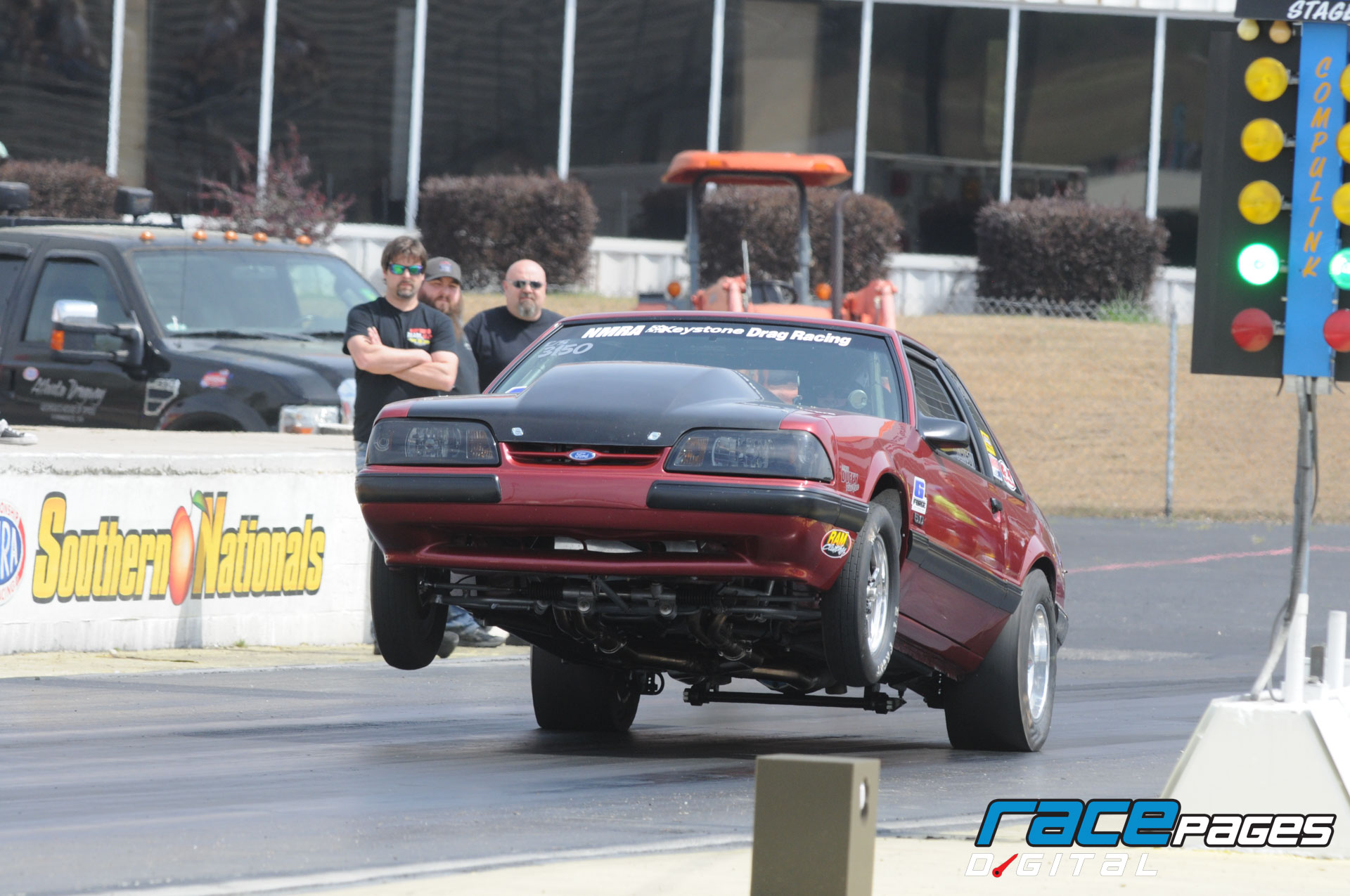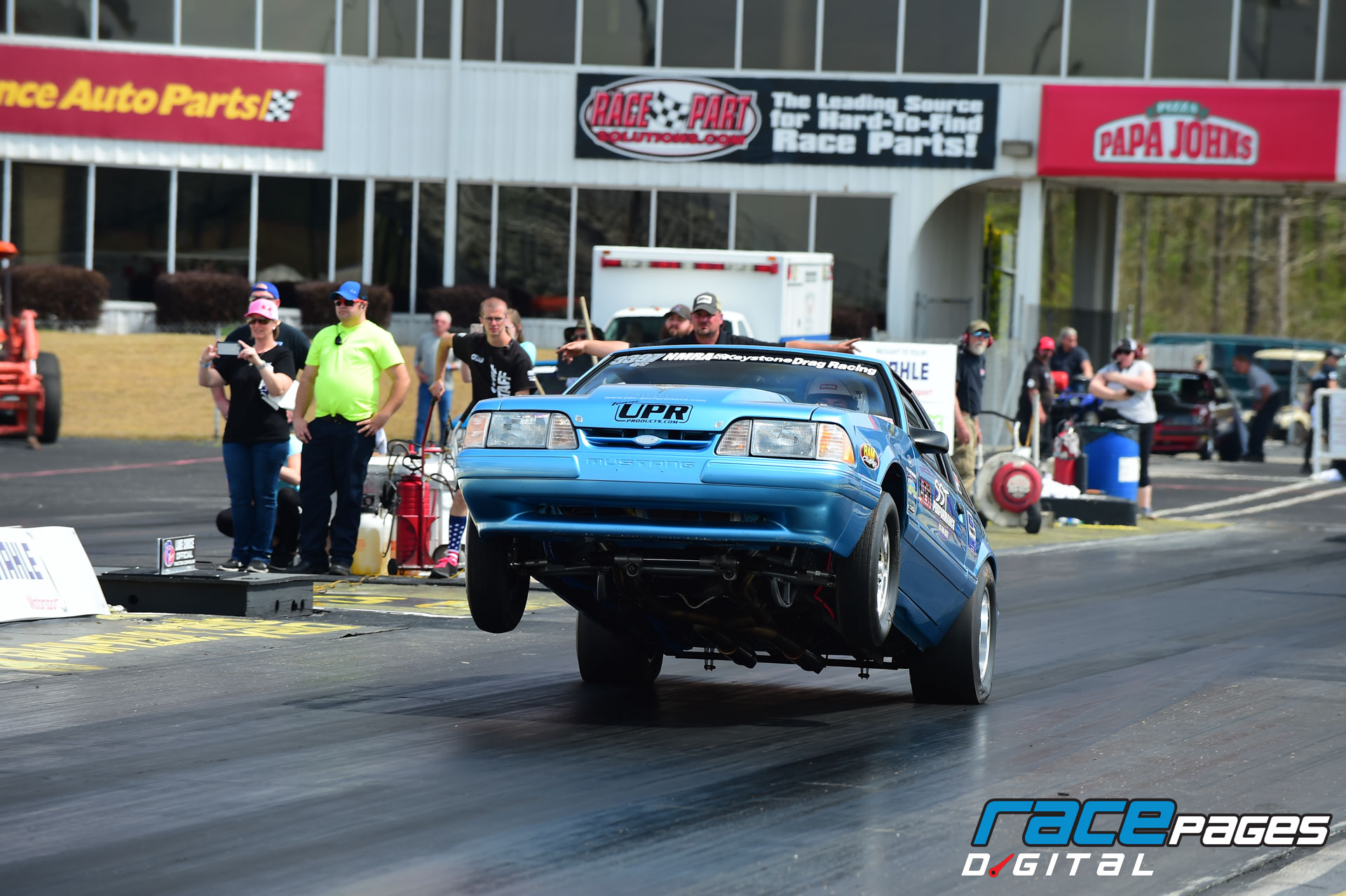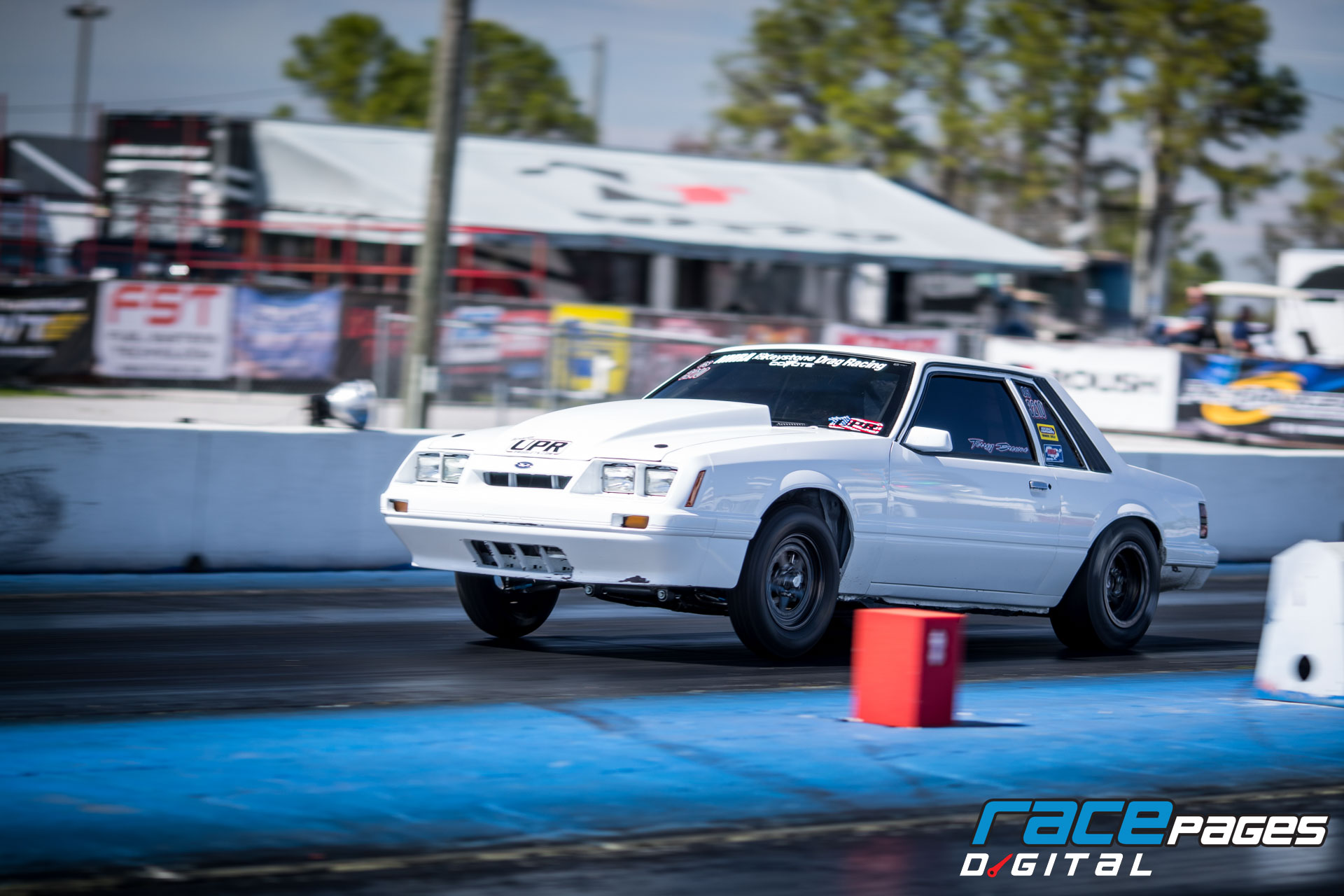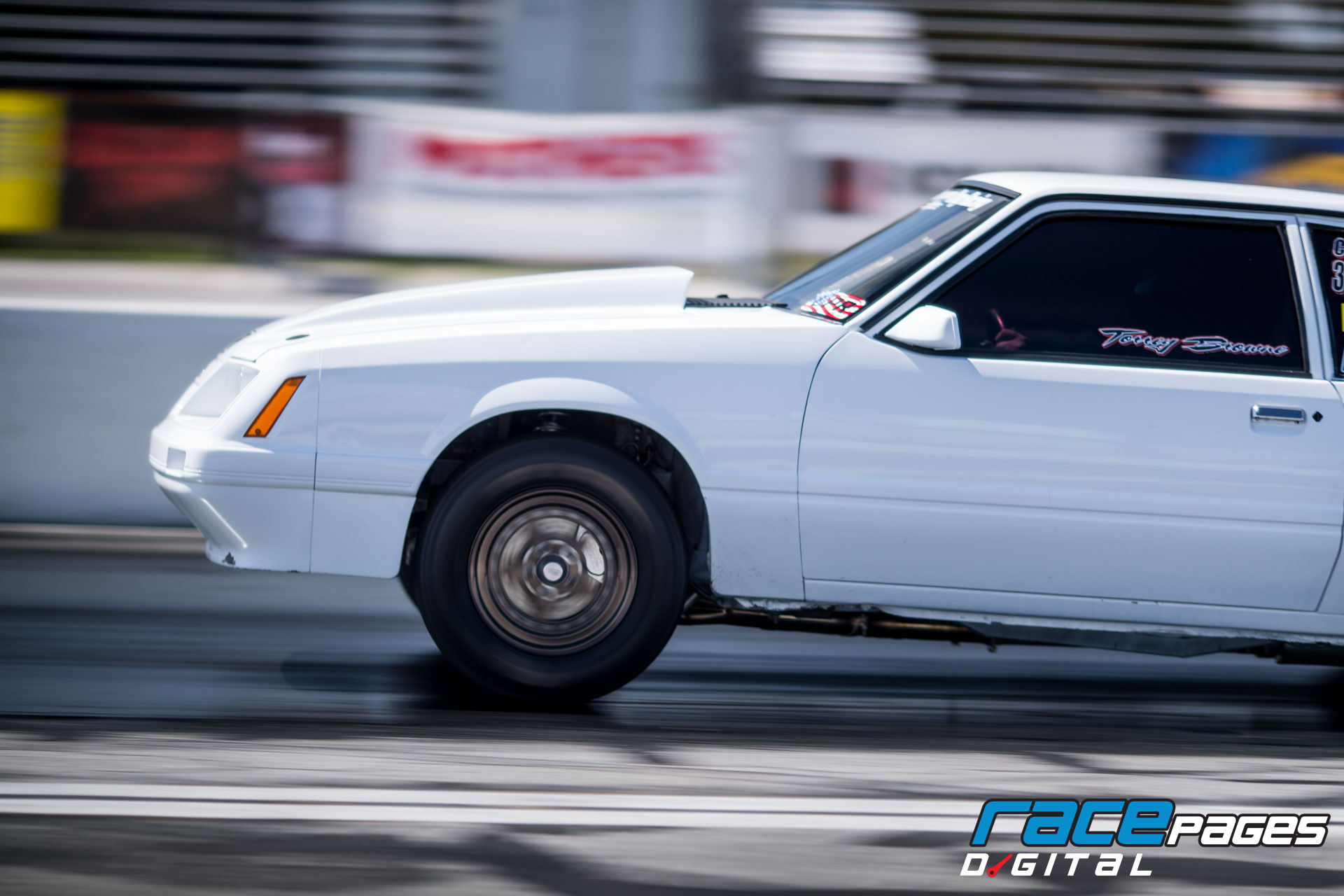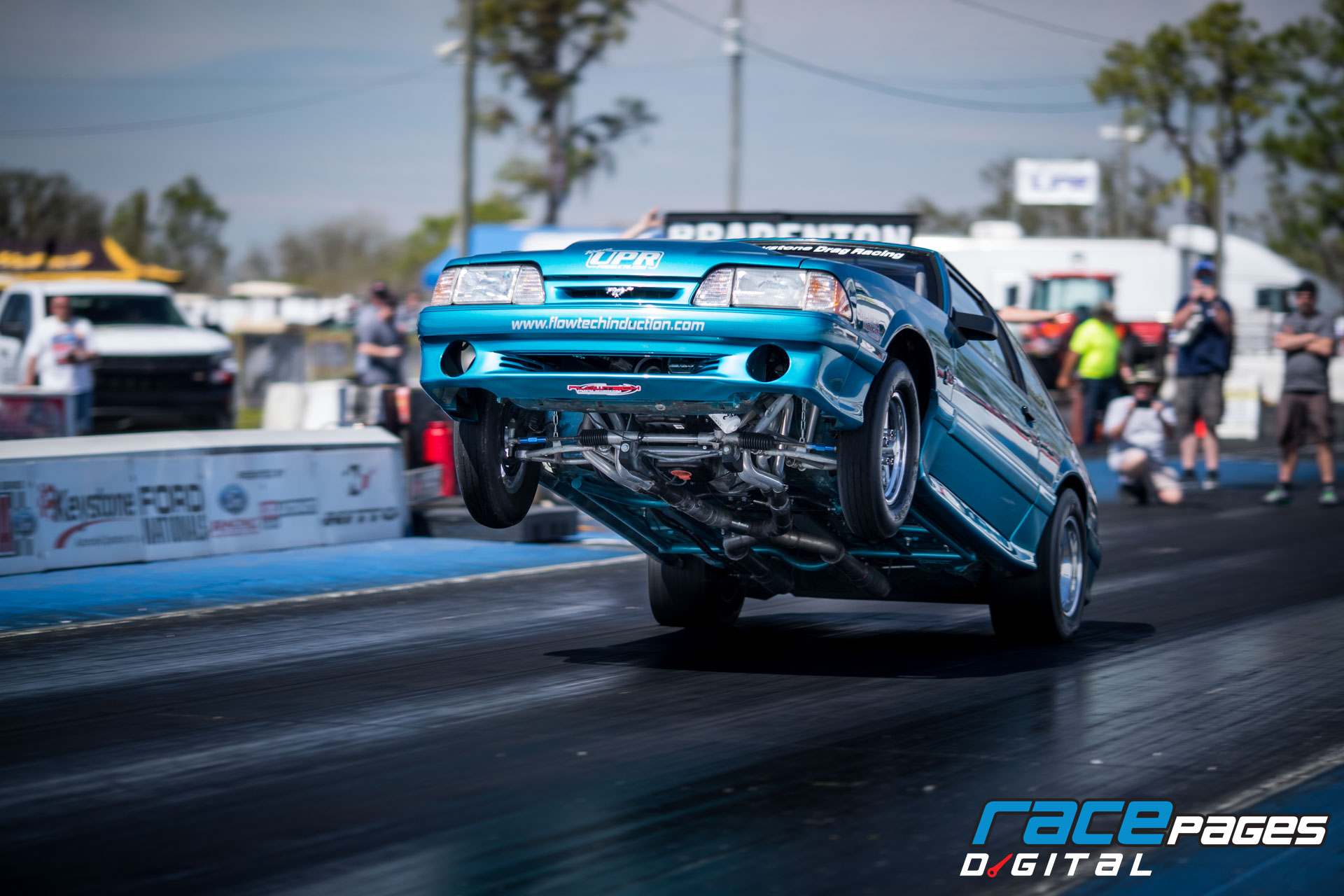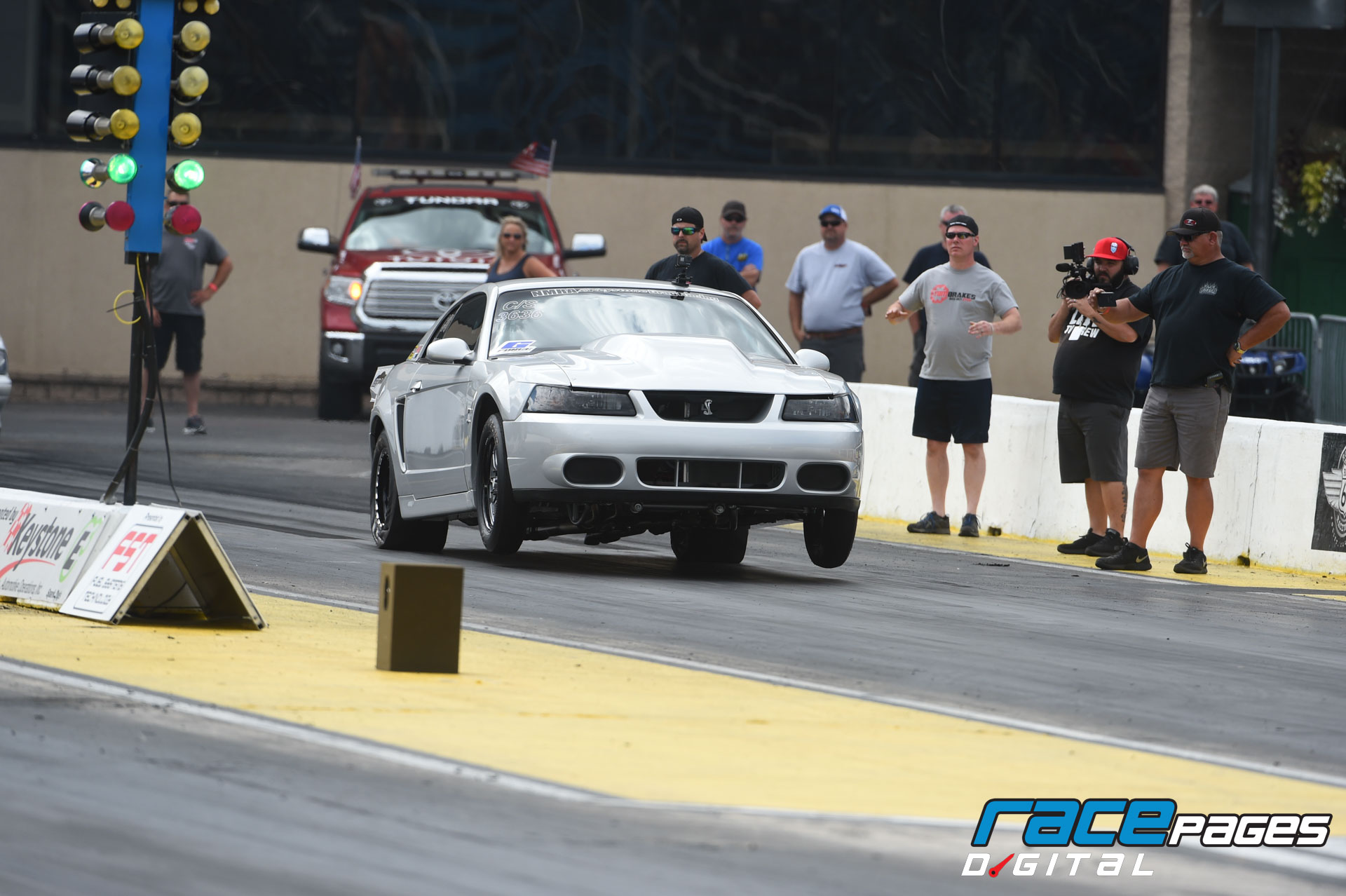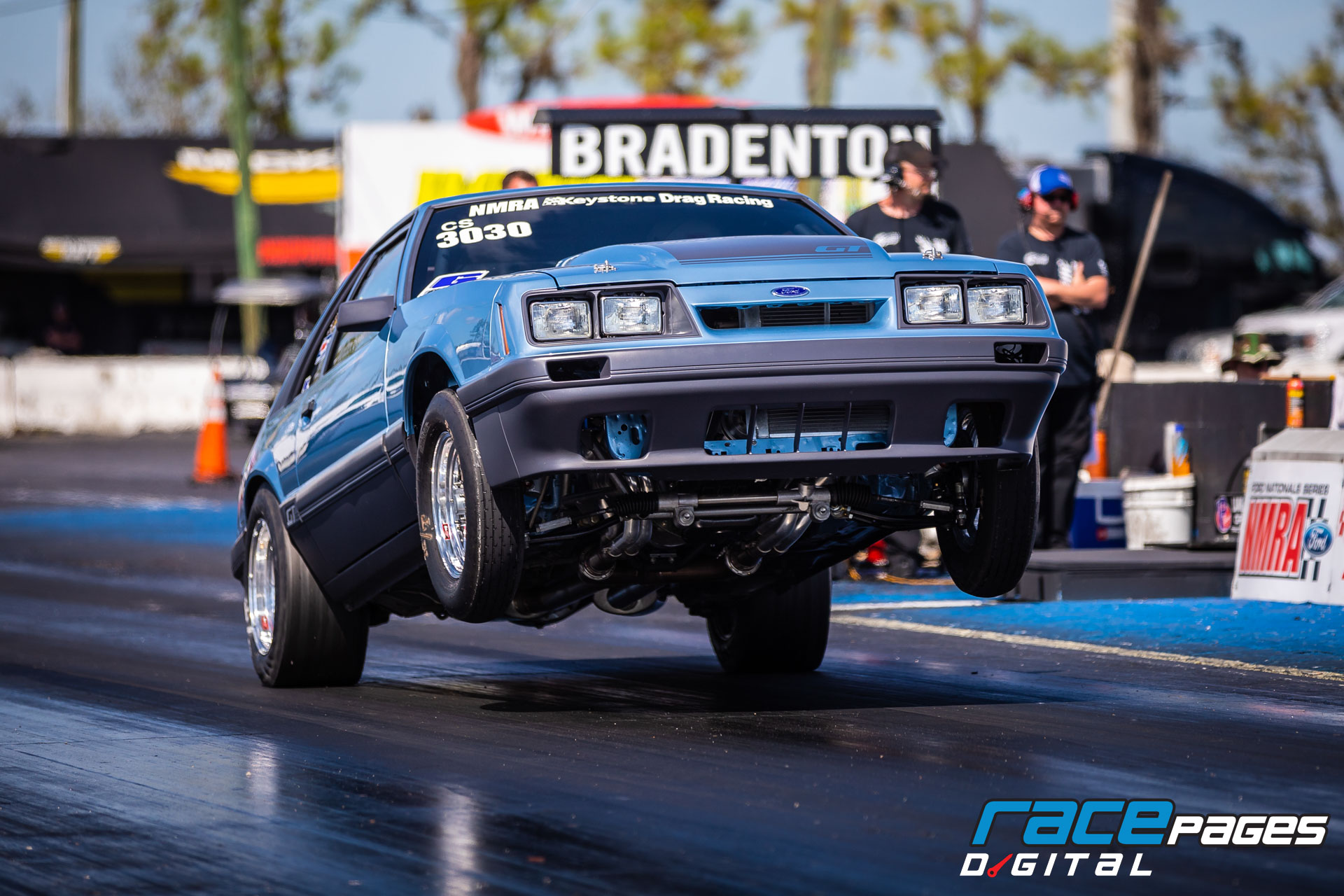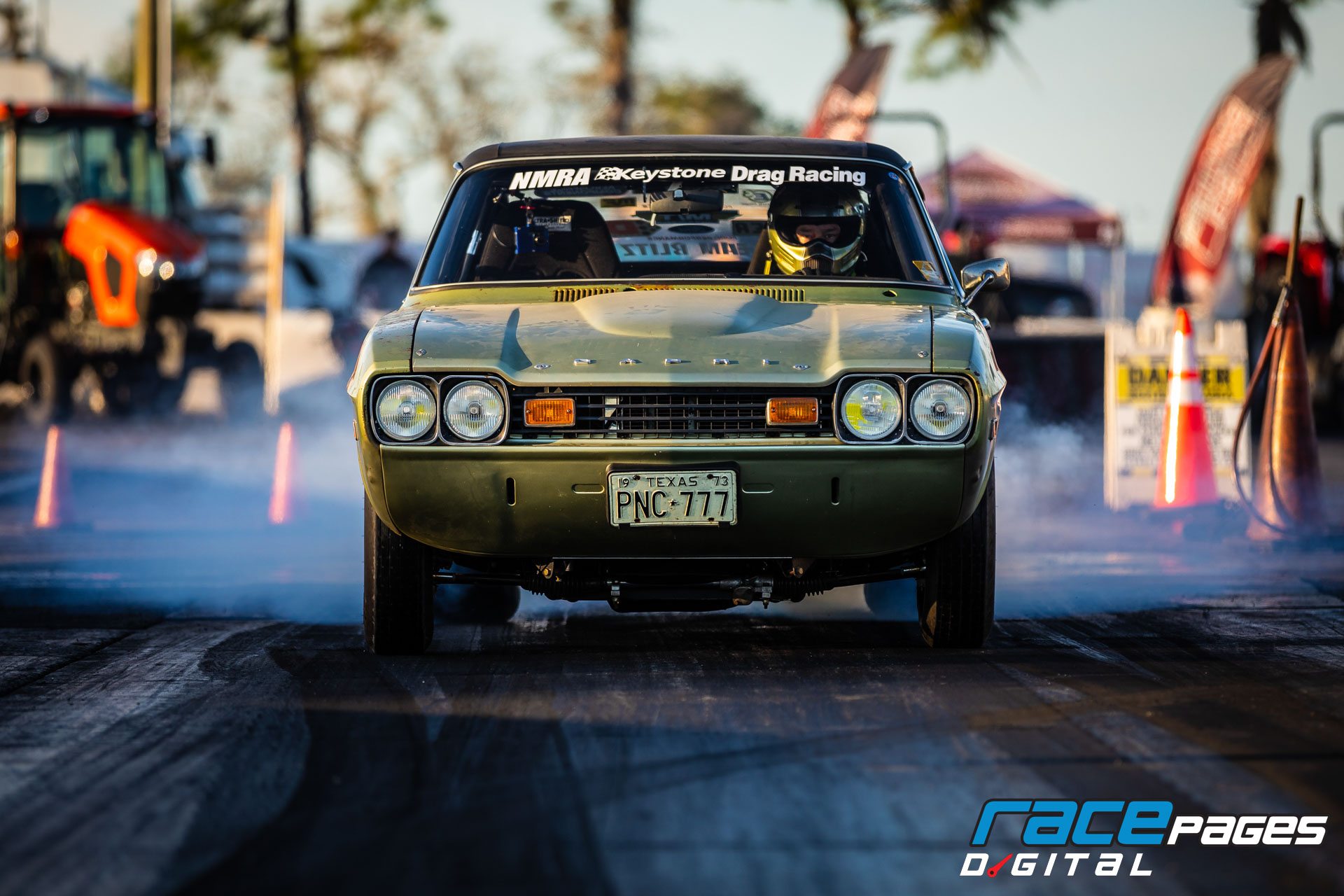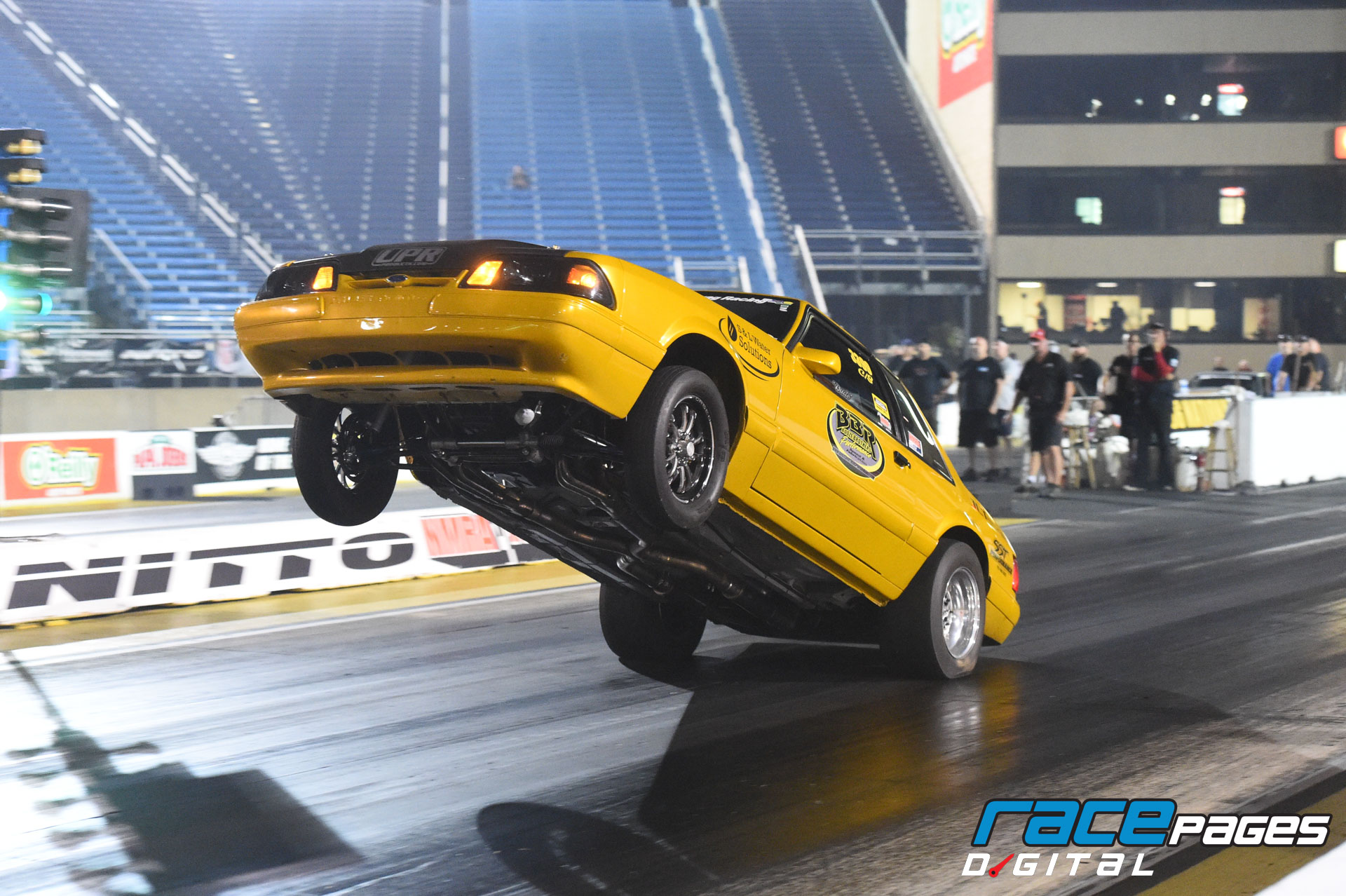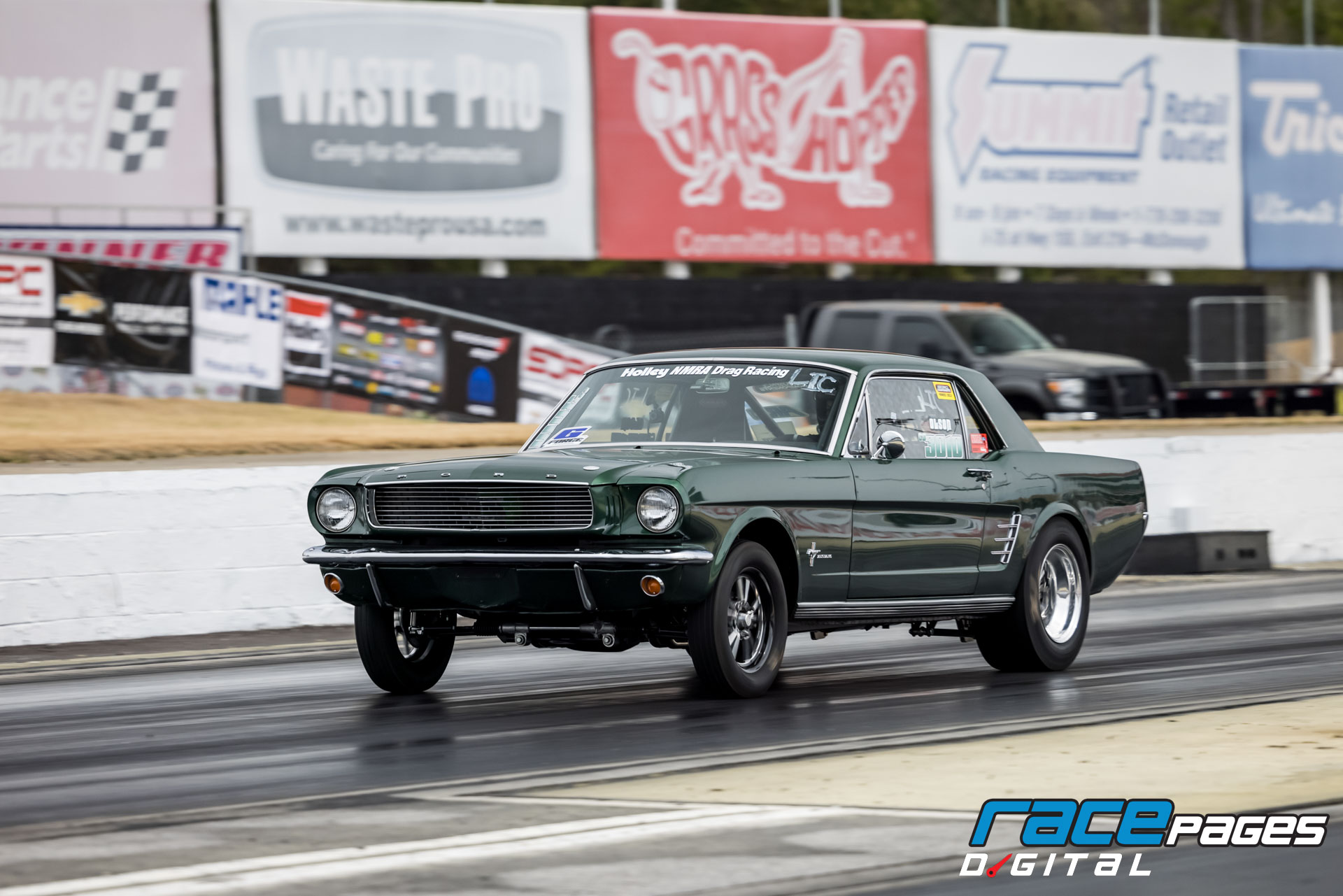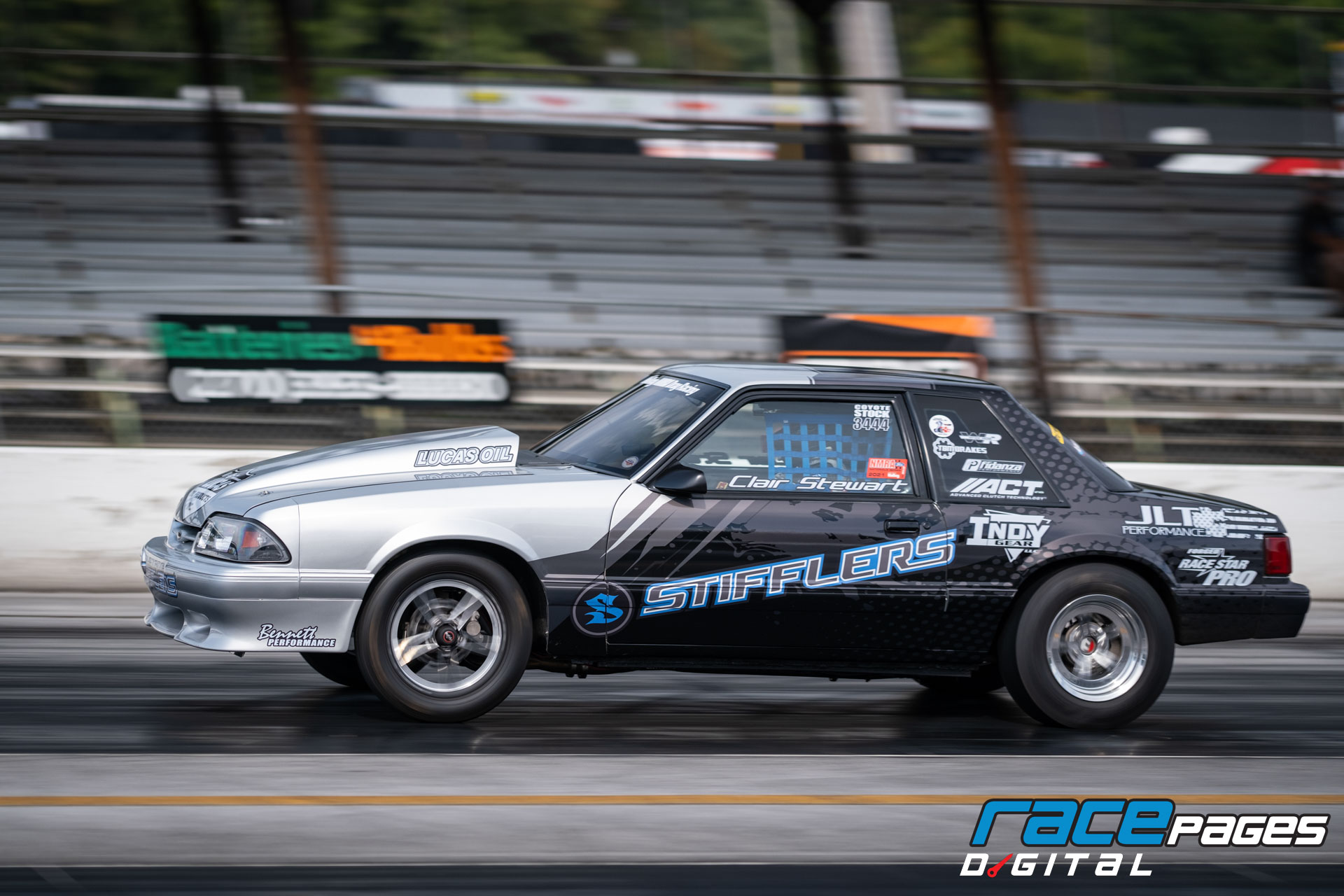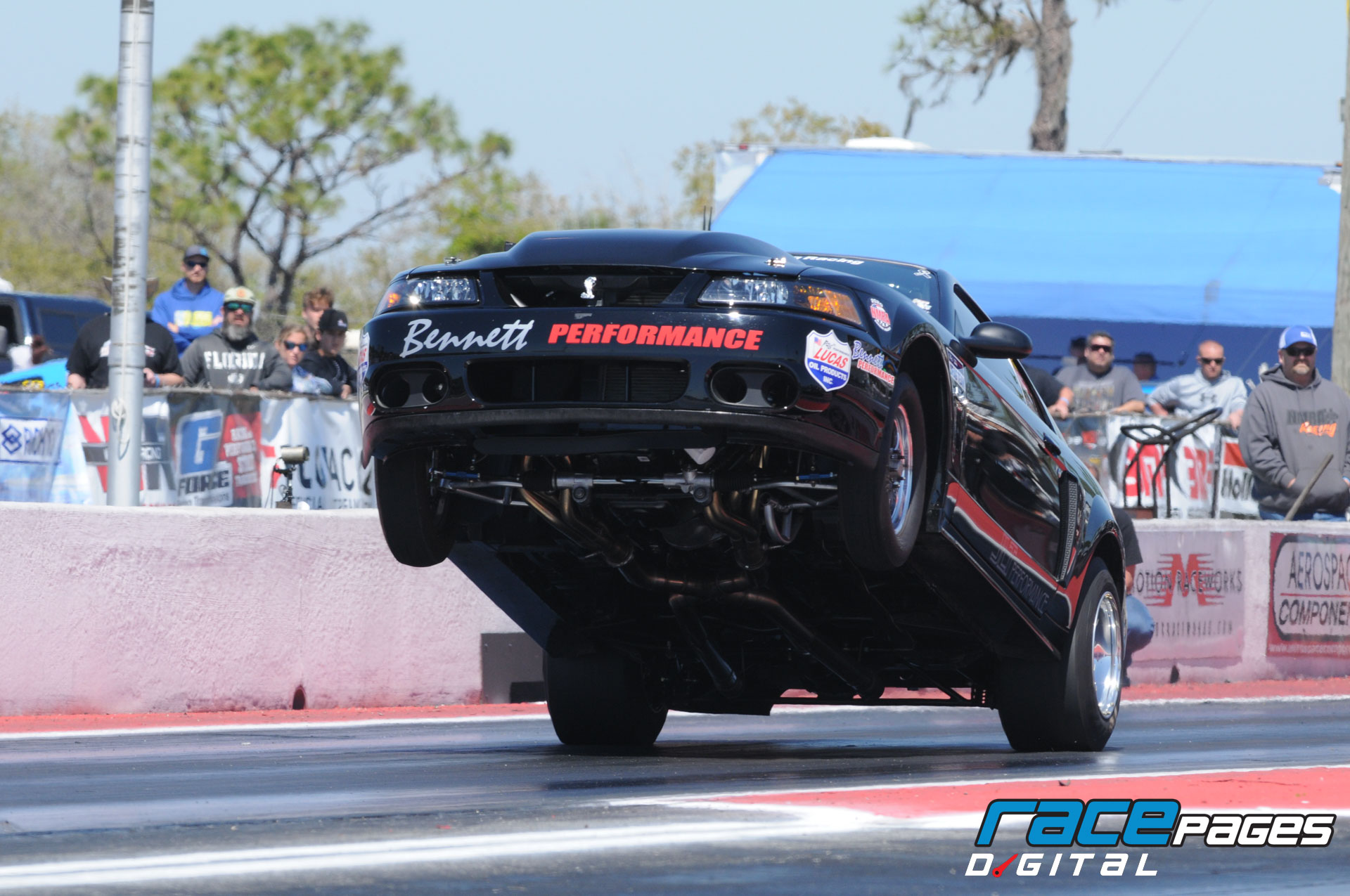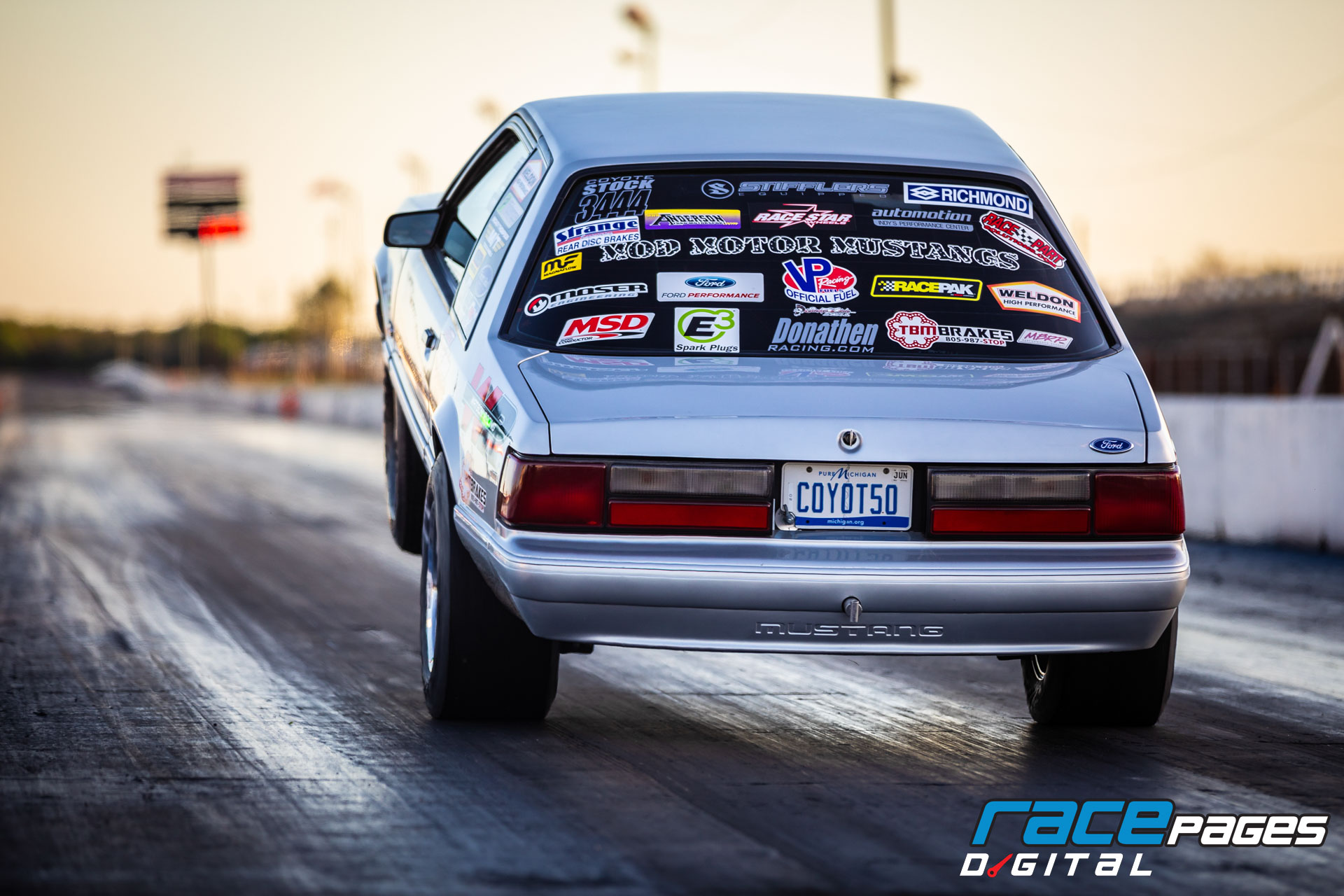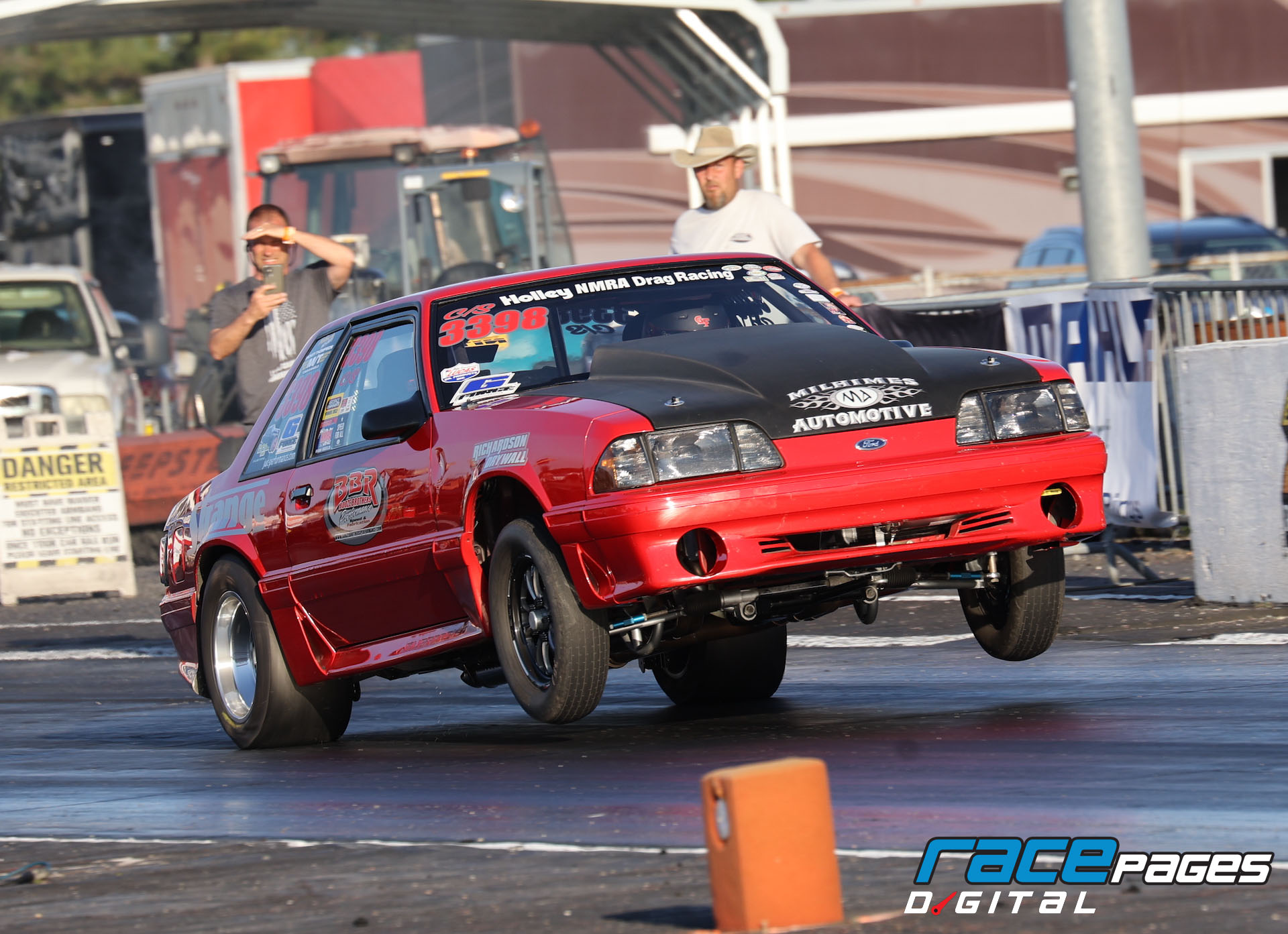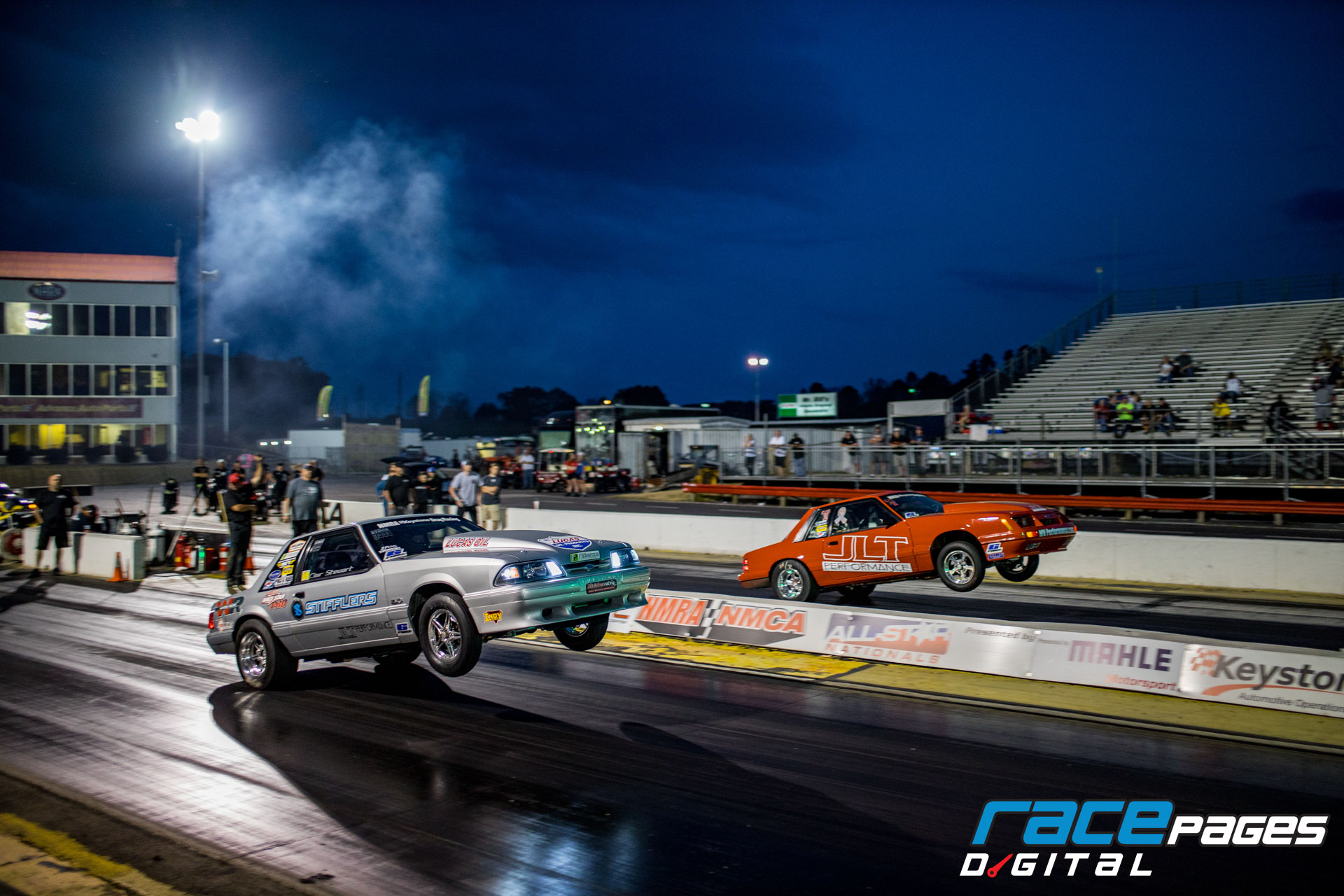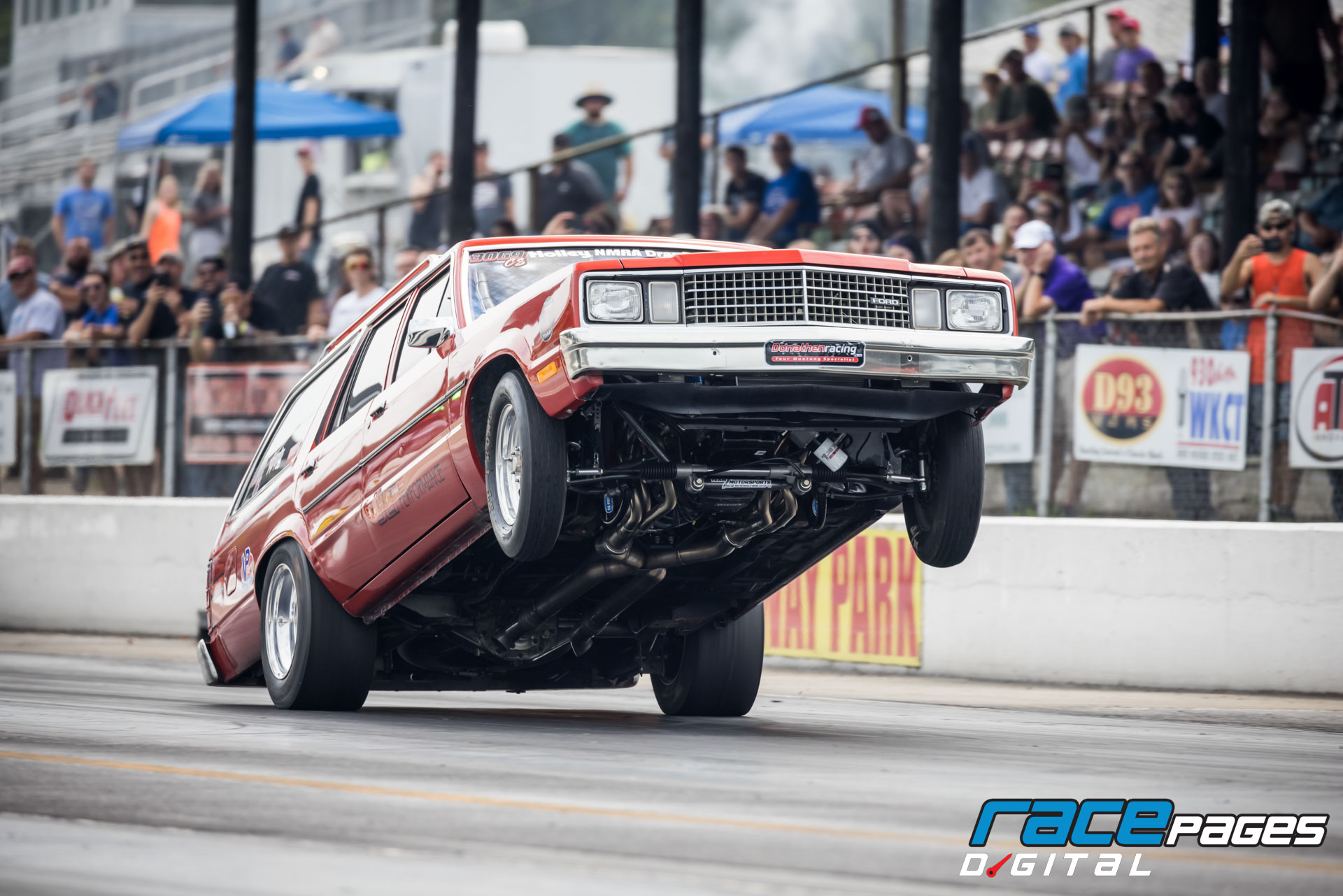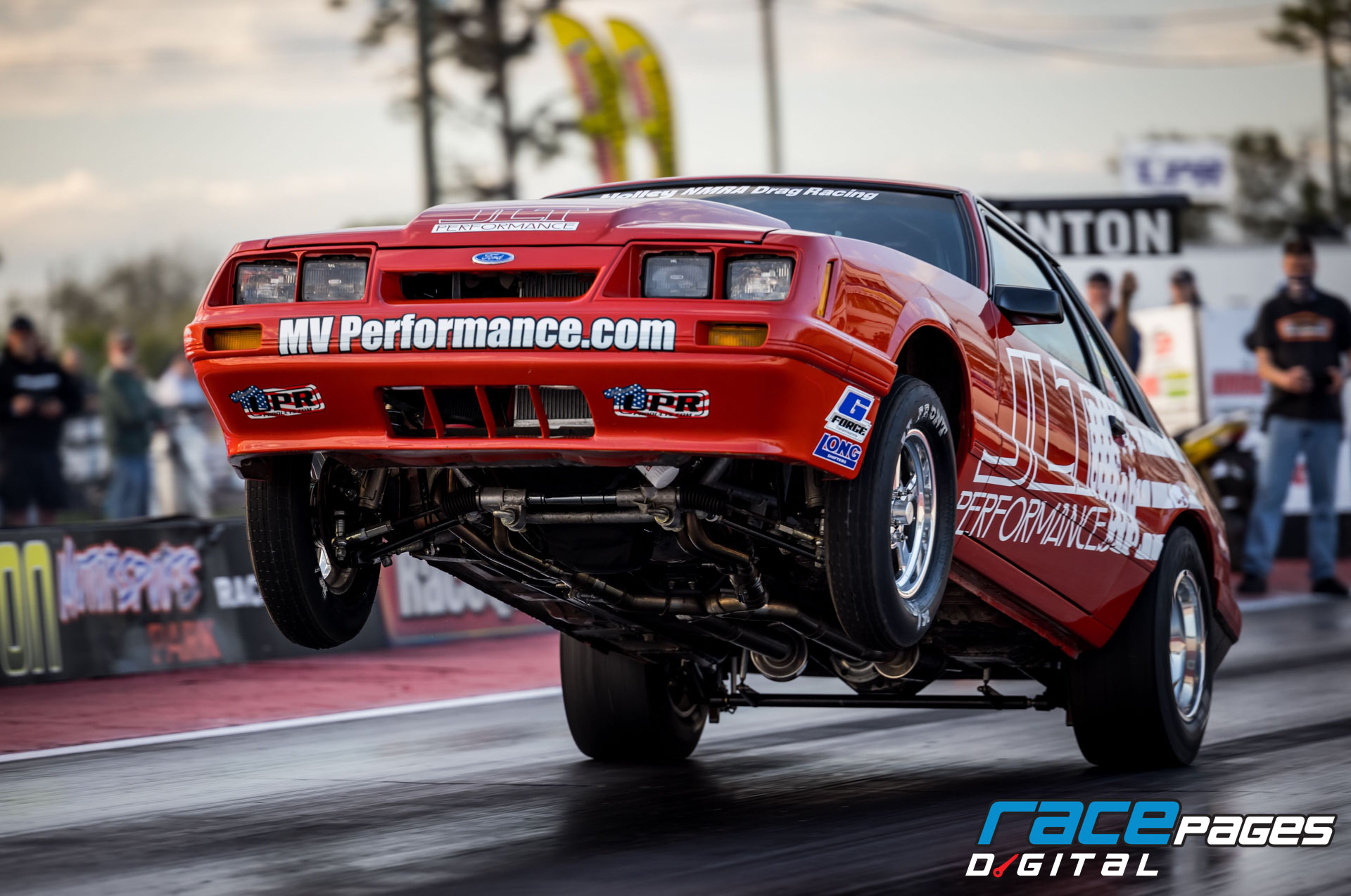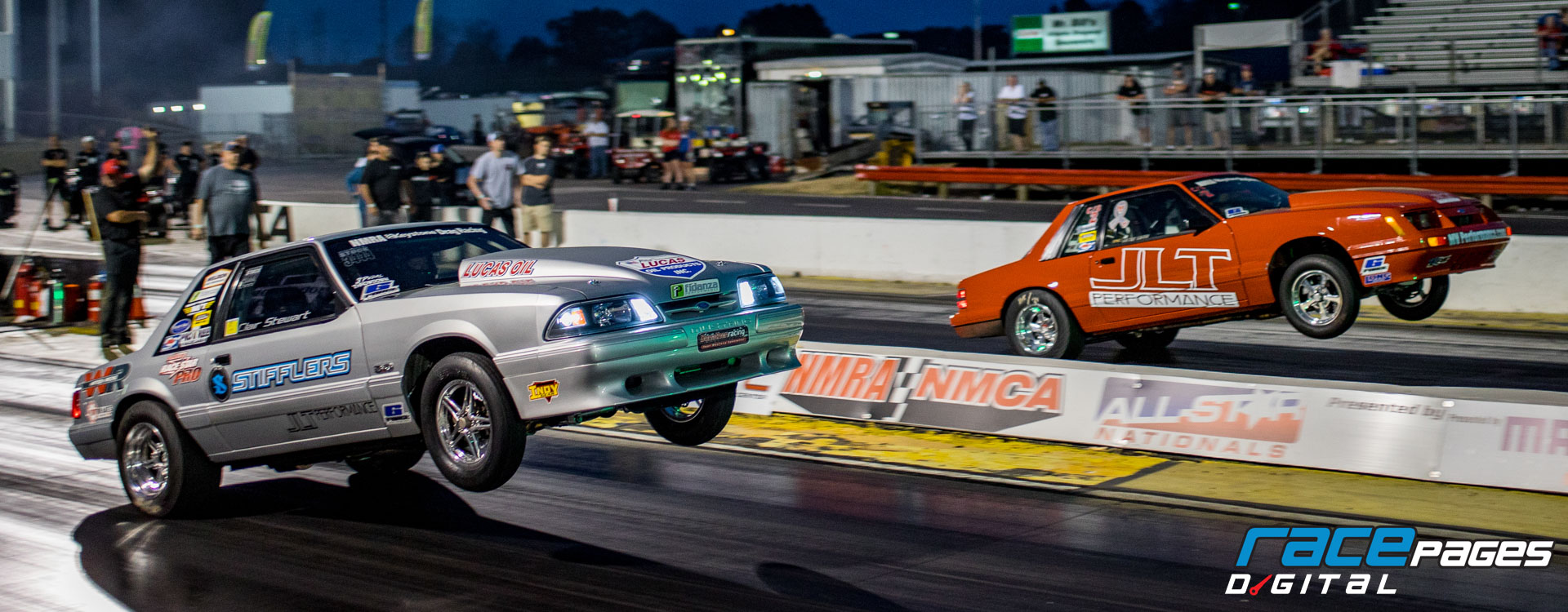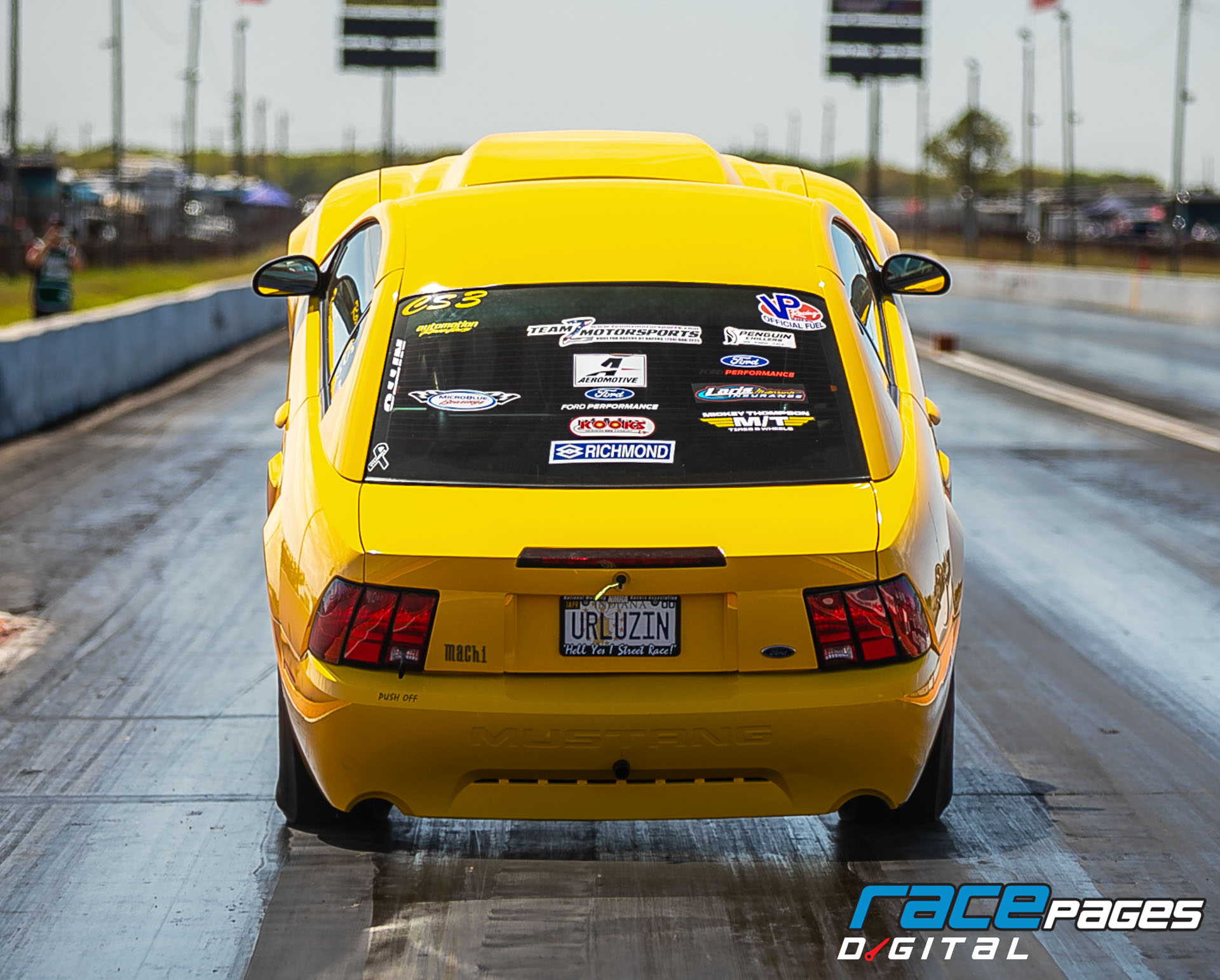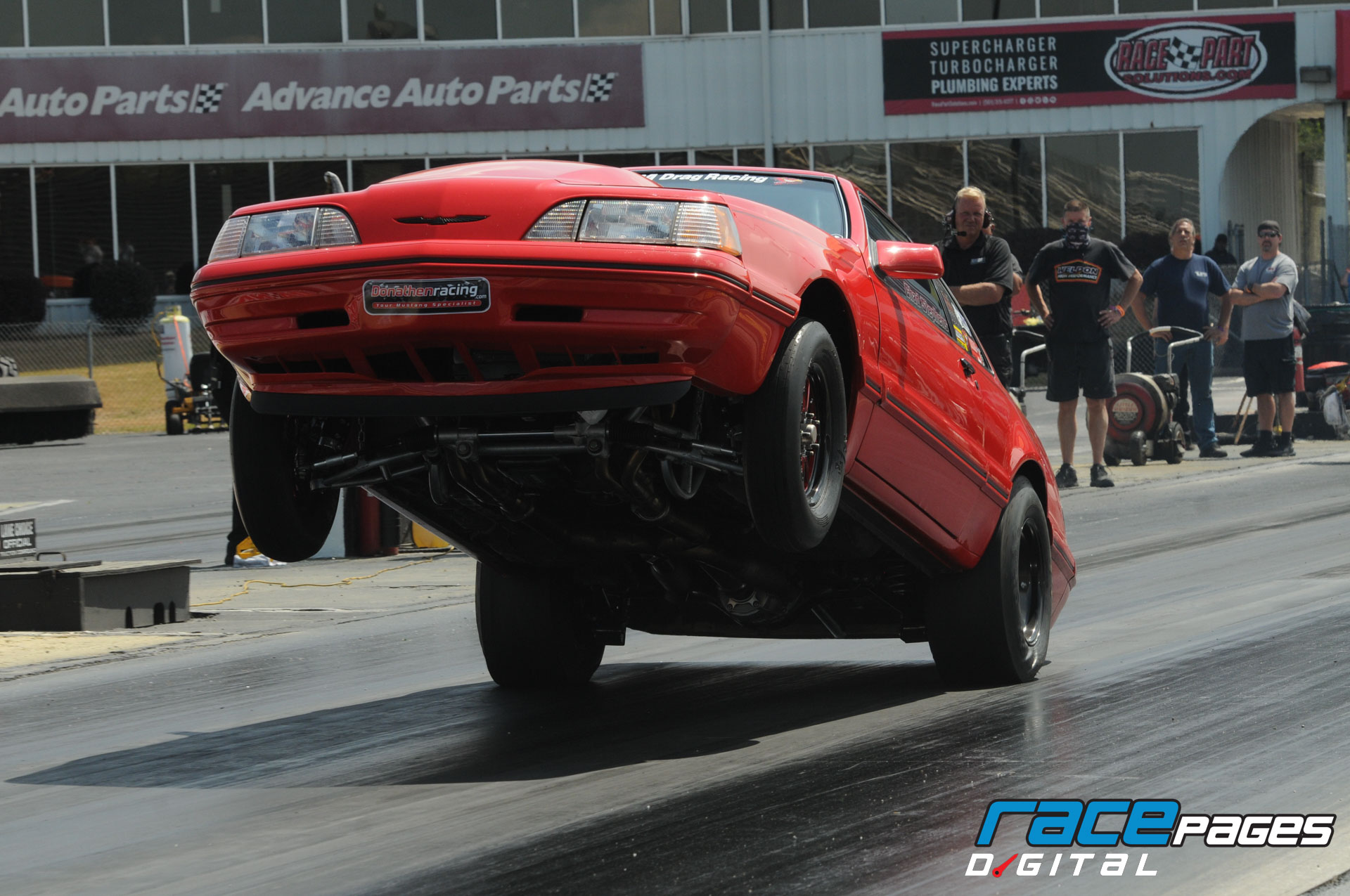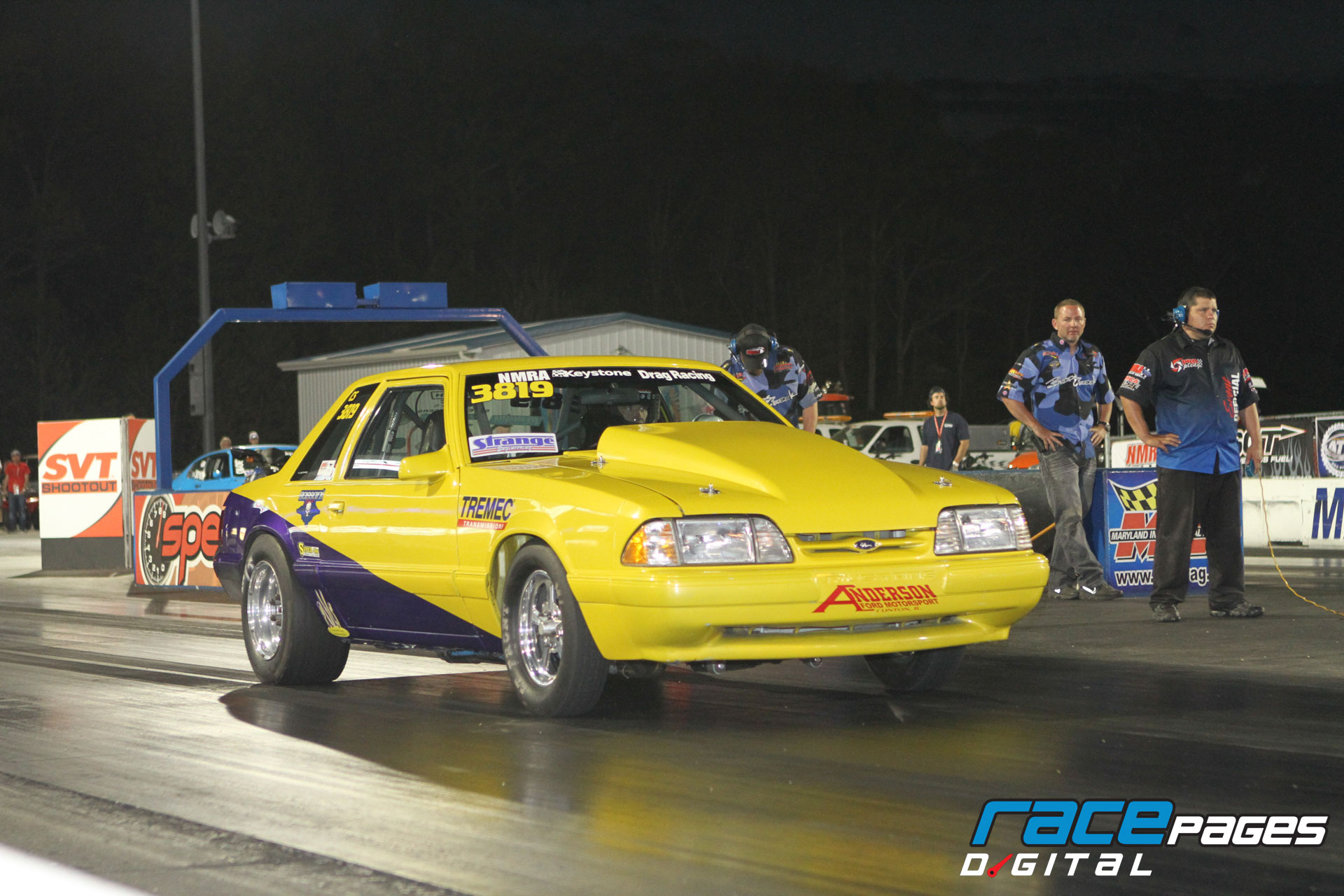Photography by the FSC staff
With 10 successful seasons solidly in the history books, one of the NMRA’s most beloved — and craziest — classes, G-Force Racing Transmissions Coyote Stock, is still rapidly gaining momentum and the future is looking even brighter.
The heads-up eliminator category, which centers around a OEM sealed, stock 5.0-liter Coyote crate engine and sealed Powertrain Control Module with calibration from Ford Performance, helps curb the ever-rising expenses associated with competitive drag racing. The class, though, wasn’t developed by the NMRA sanctioning body or even by an official – it was created by racers and inspired by frustration.

Steve “The Farmer” Gifford and Ken Bjonnes, both longtime drag racers with tons of seat time to their names, were involved in NMRA Pure Street and NMRA Factory Stock in the late 2000s. After several seasons and countless dollars spent, the men grew weary of the escalating costs and circumstances.
Gifford, who raced on the professional motocross circuit for a few years, chased a championship in NMRA when he wrecked at the World Finals in Bowling Green, Kentucky, and negated an entire season’s worth of work.
“After stripping the car down, I started thinking about all the money I spent for the BES engine and everything else to not win a championship,” recalled the driver, who hit the wall three times after his Mustang pushed a valve cover gasket out. “I thought I was the dumbest human on the face of the Earth… it always bothered me to be chasing rules,” he said.
At the time, Gifford was talking with Ken Bjonnes, formerly of Modular Depot and current main man at Palm Beach Dyno, on a nearly daily basis. Bjonnes had shifted gears from racing to assisting others, and he helped Gifford with his program.
“Back then, they tore us down pretty often. There were also big rivalries between the modular guys and the pushrod guys,” shared Bjonnes, who was active in the yearly forum-based arguments regarding rule changes and the pursuit of parity in Pure Street and Factory Stock. “Some people played the game better than others when it came to sandbagging or writing rule proposals or timing their change requests, and it got old.”

Jacob Lamb
The NHRA Pro Stock class, ironically, both simultaneously bored Bjonnes and intrigued him. With a specific set of “spec” requirements, the class effectively eliminated the need for constant rule change adjustments and put the focus on driver skill and chassis setup. “We wanted Pro Stock but more on our level. We had a dream of a ‘non-rule’ class where everyone had the same set of criteria,” added Bjonnes, who was tired of seeing racers exploit rulebook loopholes.Around the same time that Bjonnes’ and Gifford’s dissatisfaction was growing, Ford Performance announced its Coyote crate engine and engine control pack. The Four-Valve, 302 cubic inch dual-overhead cam V8 was first produced in 2010 for the 2011 model year, and was an evolutionary offshoot of Ford’s famous modular V8.
“Instead of us spending $10,000 in the off-season to get five horsepower on a naturally aspirated engine, we could get a Coyote engine and spend on just racing itself, and maybe there would be more people there without rules and expenses killing everyone,” Bjonnes continued of the budding idea inspired by Ford’s announcement.
Gifford, too, loved the idea. “People were discovering the Coyote’s potential and I was thinking of the dozens of Pure Street, Factory Stock, and Real Street cars just sitting on jack stands because the owners either ran out of money or were smart enough to quit spending it,” laughed The Farmer.
Together, Gifford and Bjonnes conceptualized a class with one weight for one combination and no weight breaks – not even for automatic transmissions. Essentially, they used the Pure Street rules as a foundation and got rid of anything that pertained to different engine combinations.
Next, they contacted Jesse Kershaw, who had been an integral part of Ford’s Special Vehicle Team and Ford Performance divisions for nearly two decades, and discussed the opportunity. As Ford had already been offering sealed crate engines for circle track racing, it wasn’t a huge departure to consider the same for drag racing use. Kershaw saw the potential of such a program and suggested both sealing the engines as well as running a Ford-supplied ECU calibration to make sure everyone ran on a level playing field.
With the proposed ruleset firmly established — including all entries competing on a stock-style suspension and at the same base weight – the guys brought their plan to the NMRA tech department, led by Thom Bates. The group worked with Ford’s engineering department to ensure both the VP Racing Fuels C10 unleaded race fuel and popular cold-air intake kits would work with the Coyote platform. It was thanks to Ford’s backing that the ball got rolling quickly.
Although the response, internally, was encouraging and positive, the men remember that many others were not so optimistic. There were public debates over why the class wouldn’t work, but Bjonnes and Gifford held their ground.
One of the biggest fears was that the newly created Coyote Stock category would allow for the use of automatic transmissions and that that would kill the entire model of the class because those racers would want weight breaks. “We were adamant that it was a stick-shift only class,” noted Gifford, “but finally conceded and added where people could run a C4 transmission – even though we knew it wouldn’t be competitive.”

Tim Matherly
Many racers were excited by the concept and eager to give Coyote Stock a try. “I had a race car a long time ago and even won six races in a row back in ’99,” reminisced Joe Charles of his modular-powered Fun Ford days. “Then I went through a divorce and sold everything, so, when they announced Coyote Stock, I knew it was something I wanted to try — and I got the blessing from my new wife, Kelly.”
Charles’s friend and fellow racer, Tim Matherly, had an old Real Street ride just sitting idle. So, Charles ordered up a new Coyote engine and Control Pack – the first one of each to be shipped from Ford — and Matherly had the car up and running in just a couple of days.
Next, the two men from Georgia headed over to nearby Carolina Dragway “The House of Hook” in South Carolina for some testing. On just the second pass ever, Charles rowed the gears to a 10.90s timeslip and couldn’t wipe the Coyote-induced smile off of his face.
The inaugural season of NMRA Coyote Stock was run in 2012, with the first race of the year taking place at Florida’s Bradenton Motorsports Park in March. There, the top qualifier for the new category was Charles whose 11.135 at 121.53 mph pass was no slouch for the Gen 1 combination at the time. Charles went on to win the race outright, with Joe Guertin not far behind as the runner-up.
“We played it real smart – only running as quick as we needed to win and resetting the record over and over to get as many points as I could,” confessed Charles, who won four races in total that year and went on to win the first-ever NMRA Coyote Stock season championship in 2012.
 Justin Burcham
Justin Burcham
Several other big names in Ford drag racing made the move to Coyote Stock, too, with both JPC Racing’s Justin Burcham (who set the class elapsed time record at 10.558-seconds) and Shane Stymiest (with an automatic at first) also taking trips to the winner’s circle in 2012 and Jacob Lamb joining in as an early adopter.
“It was my first time racing heads-up with the NMRA and it was — and still is — such a competitive class,” Lamb remembered of the early days. He took a trip to the final round at the race in Joliet, Illinois, but came up just shy of the win. “I was really excited for a class I could actually compete in. I didn’t know anyone in the beginning and wasn’t really competitive, but by the second year, they all knew I was there.”
Those first five racers to commit to Coyote Stock were all integral in the class gaining traction, momentum, and ultimately long-term success. Super exciting competition and rivalries spurred growth; in its second year, full fields were the norm and the Coyote Stock action definitely ramped up as the class attracted many multi-time NMRA champions to the chase.Interestingly enough, Bjonnes believes that the most critical part of the class’ success was him “being a huge jerk for the first two years.” According to him, Bjonnes was “super hardcore” when it came to sticking to his guns in regards to Coyote Stock being a stick-shift category. “At the time, I felt the class was in danger of being destroyed if we threw in the towel and allowed automatics in just to get the car count up,” he clarified. Fortunately, that wasn’t the case.
Meanwhile, Gifford had made the conscious decision to sit out early on and not compete for fear that it “wouldn’t look right” if he was successful right out of the gate. Instead, he helped from the background and slowly worked on converting his old Factory Stock entry to fit the new Coyote Stock rules. In 2014, Gifford made his debut and even finished ninth overall in points for the season.
“I knew it would be a successful category, but I never expected the magnitude it would attain,” shared the man who was simply trying to avoid fighting rules from different engine combinations and make a fair class where driver skill determined the outcome, not their wallet. “I knew the class was a success when Tim Matherly quit racing the fast cars and came back to have fun running a slower car.”
Over the years, the NMRA G-Force Transmissions Coyote Stock class grew from a simple concept to a stunning sensation. It’s not just drivers who love being able to compete — the fans love watching, too. Wild wheelie action is practically guaranteed as the Coyote-powered entries respond best off the line with the front ends pointed sky-high. The competition itself is incredibly close with a typical qualifying sheet showing the top 10 drivers separated by a mere tenth of a second or less.

As much as the success of Coyote Stock is credited to the dedication of its racers, the true force of its popularity and longevity is Ford’s commitment to the Coyote crate engine program.
While the Gen 1 Coyote was the foundation of Coyote Stock for its formative years, Ford eventually released its Gen 2 successor in 2015. “Given that we had never done anything like this before, late in the year the Gen 2 was legal but at an extremely uncompetitive weight,” explained Mike Galimi, former Director of Content & Marketing for the Holley NMRA Ford Nationals and current Network Director at Hot Rod. “It was done as a way to keep true to the theme — no chasing weight breaks or rules. NMRA tech was quite vocal that it was an uncompetitive weight and done for that reason, let the racers finish the year with their Gen 1.”
However, by 2016, the weight penalty went away and racers could choose to run either a Gen 1 or a Gen 2 at the same weight. Knowing that the Gen 2 powerplant made more power than its predecessor, the decision was made to do so in acknowledgement that the class itself is about the Coyote engine and its potential.
Ford announced the Gen 3 Coyote in 2018, but the NMRA G-Force Transmissions Coyote Stock package wasn’t available to racers until mid-2020. The lightweight, all-aluminum 5.0-liter engine was equipped with Twin Intendent Variable Camshaft Timing and delivered 460 horsepower at 7,000 rpm and 420 pound-feet of torque at 4,600 rpm with a compression ratio of 12.0:1. Internally, the Gen 3 was equipped with aluminum pistons, sintered steel connecting rods from the Boss 302 Mustang, a forged steel crankshaft, steel billet oil pump gears, and many more bells and whistles.
“There was a line drawn in the sand that said the Gen 3 would be the engine package going forward, and that’s where we are today,” Galimi continued. “Without the support from Ford Performance, this program simply wouldn’t work. Ford is a huge part of Coyote Stock and have dedicated a significant amount of engineering resources to the NMRA. Similarly, a lot of racers have stepped up to help work with Ford to facilitate changes and fine-tune the program.”
Working in conjunction with NMRA’s racers, Ford Performance was able to integrate its Cobra Jet-inspired ProCal tool into the Gen 3 Coyote. “Coyote Stock racers can use the ProCal’s software to electronically select the launch rpm they want to use without having to wire in a traditional, separate two-step system,” said David Born, Engine and Performance Supervisor at Ford Performance.
Another benefit of the ProCal tool is that racers no longer have to wait to have their PCM modules flashed at an NMRA race to receive updates or calibration changes. “We can push file changes out to them directly over the internet and they can test the new tune-up prior to a race,” Born added. “Jesse Kershaw’s initial work was a great start and it’s come a long way over time. The class gets bigger every year and we enjoy helping show what the Coyote is capable of achieving.”
Each version of Ford’s now-famous Coyote engine pushed the NMRA G-Force Transmissions Coyote Stock class further and further with performance. What began as a high-10-second category is, more than a decade later, a full second quicker with the current elapsed time record of 9.678-seconds having been set by Charlie Booze Jr. at North Carolina’s Rockingham Dragway in late April of 2022.
Although there would be no Coyote Stock class at all if not for the Coyote engine itself, another major factor in the category solidifying its longevity was the introduction of the G-Force Transmissions G101A five-speed manual gearbox mid-season in 2016.
“That was the real turning point and the biggest improvement,” Lamb recollected of the introduction of the racier transmission. The change was a positive step forward for his own program, as Lamb collected the season championship title in 2017. “We weren’t worried about breaking transmissions or having to switch to a spare between rounds anymore. I don’t know of anyone who’s broken a G101A at a race to the point where it couldn’t be fixed.”
The G-Force G101A has undeniably made a huge difference in performance for Coyote Stock’s racers as reliability, durability, and consistency have all been exponentially enhanced – but the clutch setup itself is also an important piece of the equation.
When the ClutchTamer became legal for Coyote Stock, many racers breathed a sigh of relief as they no longer had to struggle to find their clutch’s sweet spot for launching. By adjusting the slip and controlling the engagement point, racers were able leave the starting line with a softer launch at a much higher rpm.

Shane Stymiest
Many new racers have opted to join the party over the years, too, as Coyote Stock typically hosts a full field. Drawn by the relatively low-cost of entry and the unparalleled comradery that the competitors have established, Coyote Stock becam a hotbed for those wanting to get into heads-up stick-shift drag racing and have a ton of fun at the same time.Although the competition from start to stripe is always stiff and each driver goes all-out in hopes of putting their opponent on the trailer, the Coyote Stock crew is known for its “family of friends” vibe.
It’s just as commonplace to see opponents assisting one another in the pits by lending parts or simply lending a hand, as it is to see them laughing or hosting potluck-style cookouts in the pits after racing is done for the day. Simply put, the racers are loyal to the NMRA G-Force Transmissions Coyote Stock class but, even more so, they are loyal to each other.
Bjonnes and Gifford’s original frustration-fueled inspiration grew into something sustainable that has changed not only the history of drag racing, but also its future and the lives of everyone involved.
After more than a decade in existence, Coyote Stock is alive and thriving in its pure form with respect to the original intention of the class — even parity and no weight breaks for automatics — just pick a combination and come run with the crazy camp of Coyote Stock.




